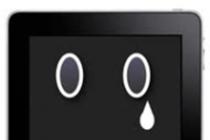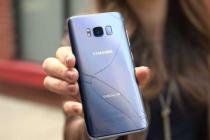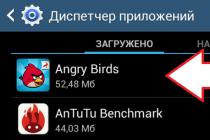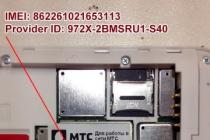The front camera is content with a 5-megapixel sensor and a wide-angle lens with a fixed focus. The maximum selfie resolution is available with the classic aspect ratio (4:3) - 2560x1920 pixels (5 MP), and for widescreen gruff (16:9) - 2560x1440 pixels (3.7 MP).
Both cameras can record videos from Full HD resolution(1920x1080 pixels) at a frame rate of 30 fps. At the same time, for four times slow-motion video (slo-mo), the main camera provides quality [email protected] fps (960x540 pixels), and the front one - [email protected] fps (1280x720 pixels).
The Camera app has a very clean interface. So, to take a picture, you should touch the screen anywhere. Zooming in the viewfinder is done by swiping up or down. If you quickly rotate your wrist twice, you can launch the camera from standby or switch between the main and front cameras. For manual setting focusing and exposure "paper clip" on the viewfinder should be dragged to the desired location, where the adjustment element is easy to adjust the brightness of the image. It is convenient to go to the gallery of pictures with a swipe to the left. Swipe to the right opens an arcuate bar with settings icons. It offers, for example, to select the flash mode, HDR, timer delay, slow or normal shooting, aspect ratio for photos, etc.
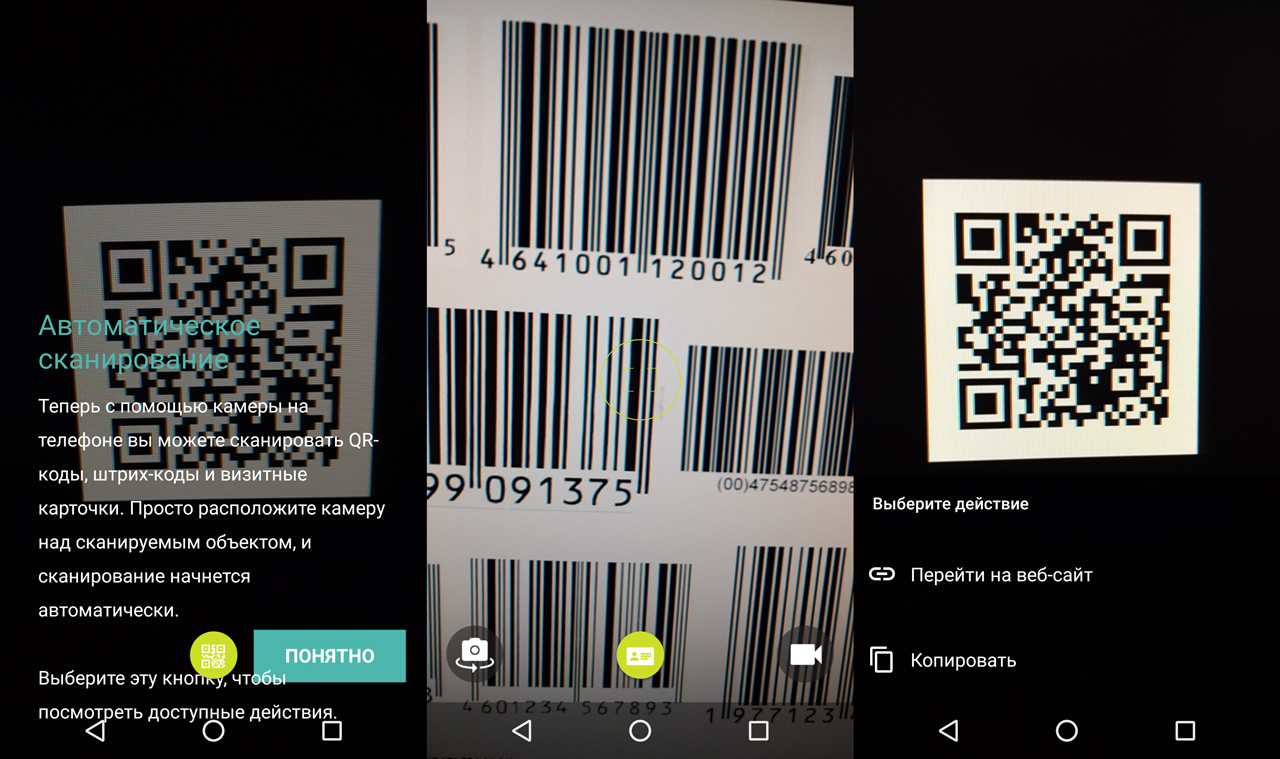
By the way, QR and barcodes are scanned automatically, you just have to point the camera at the corresponding object.
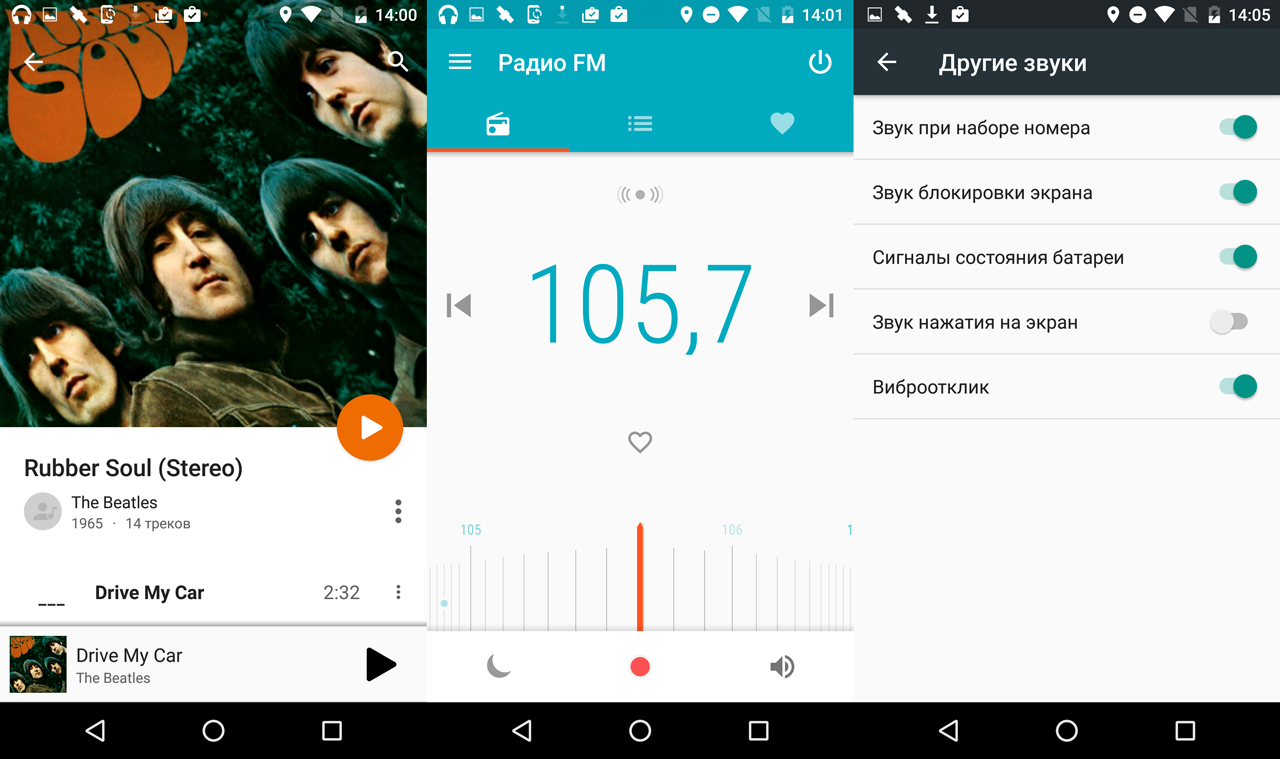
The "multimedia" speaker, located at the bottom of the front panel of the smartphone, boasts a fairly high volume, as well as a relatively clear and pleasant sound. It is a pity that a second speaker is not connected for stereo mode. So it's better to listen to music through wired headphones, since such an accessory (unlike a more convenient Bluetooth headset) will also come in handy as a shortwave antenna for the built-in FM tuner.
Filling, performance
The Moto X Play is based on a platform designed for mid-range devices - Qualcomm Snapdragon 615 (MSM8939).
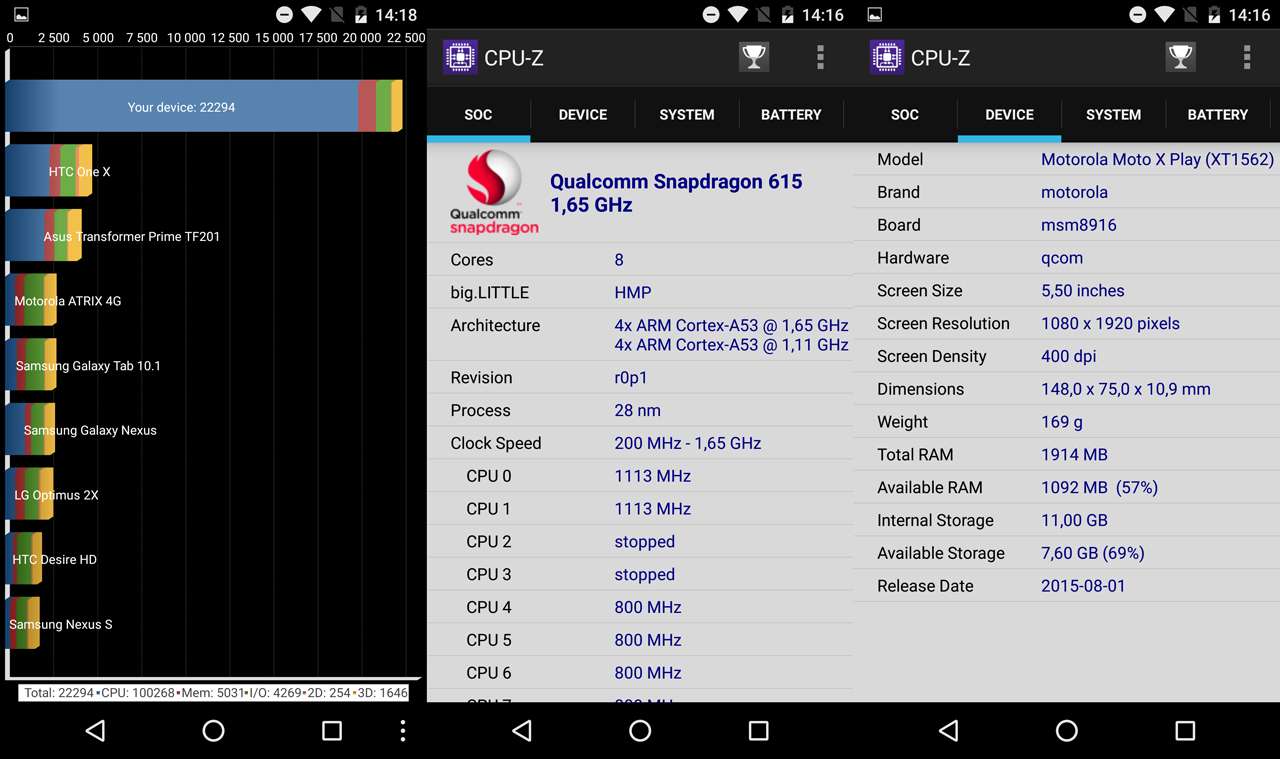
Recall that on such a chip, eight 64-bit ARM Cortex-A53 cores, manufactured using a 28-nm process technology, are divided equally into two clusters. One of them is clocked at up to 1.7 GHz and the other at 1 GHz. Integrated graphics accelerator Adreno 405 received support for DirectX 11.2, OpenGL ES 3.0 and OpenCL 1.2. The Snapdragon 615 architecture, including, in particular, the Hexagon V50 signal processor, provides for the implementation of GPS, Bluetooth 4.0 wireless interfaces, Wi-Fi 802.11a/b/g/n/ac, and a Multi-SIM modem with support for LTE Cat. 4 (up to 150 Mbps). The basic configuration of the smartphone is supplemented with 2 GB random access memory type LPDDR3 (800 MHz), which is controlled by a single-channel 32-bit controller.
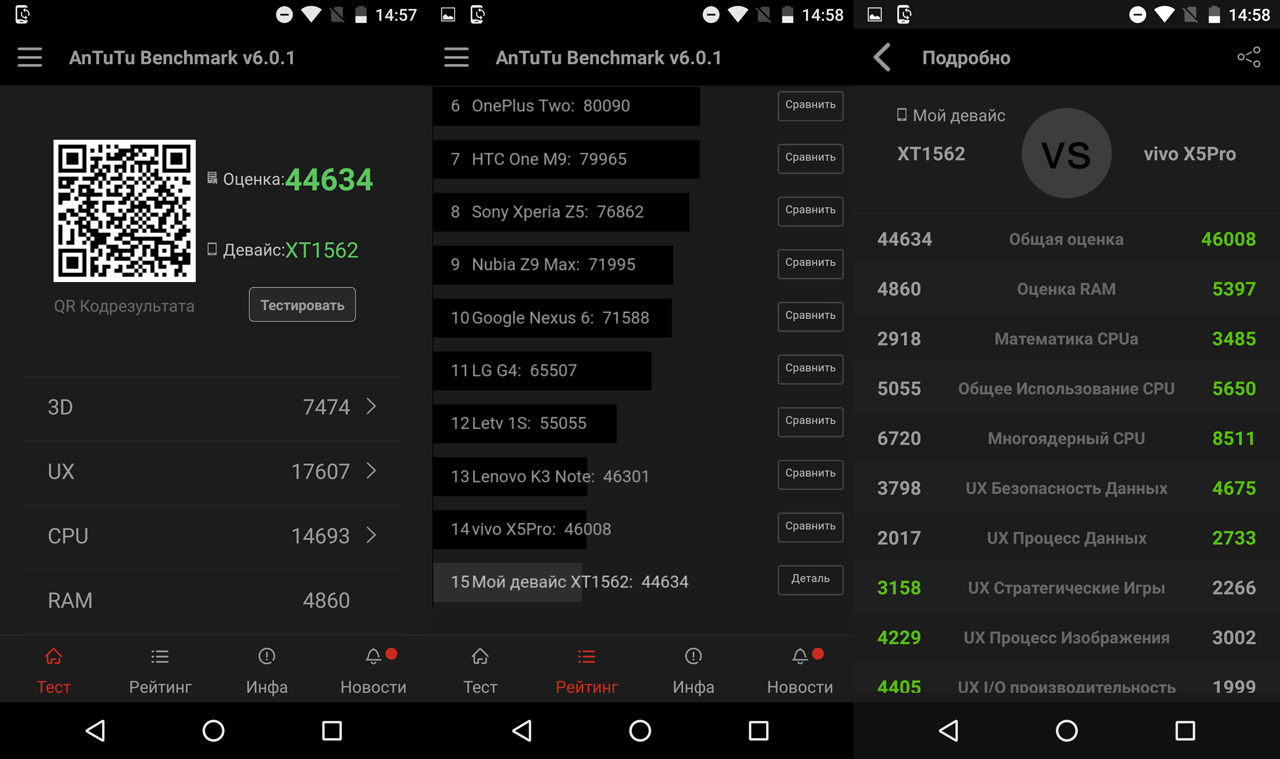
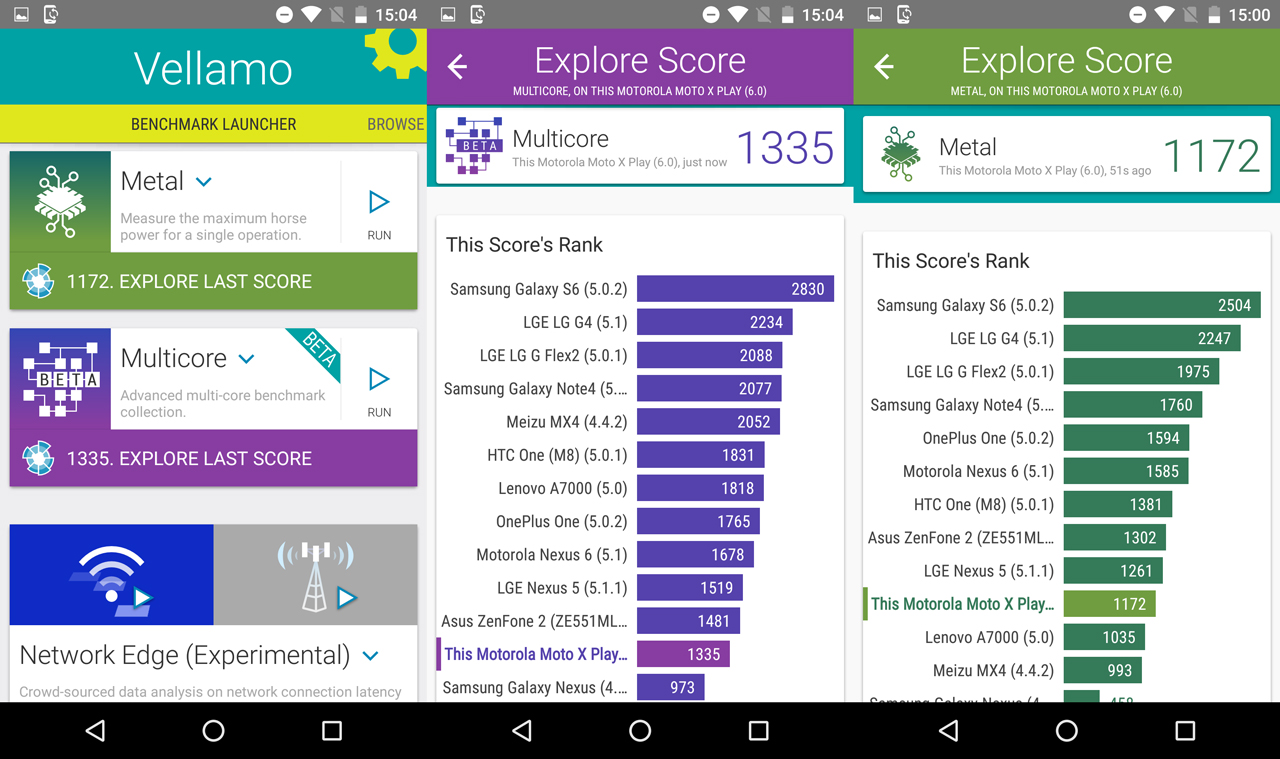
The Moto X Play hardware platform predetermined the number of "virtual parrots" it collected on synthetic tests AnTuTu Benchmark and Vellamo benchmarks (Multicore, Metal).
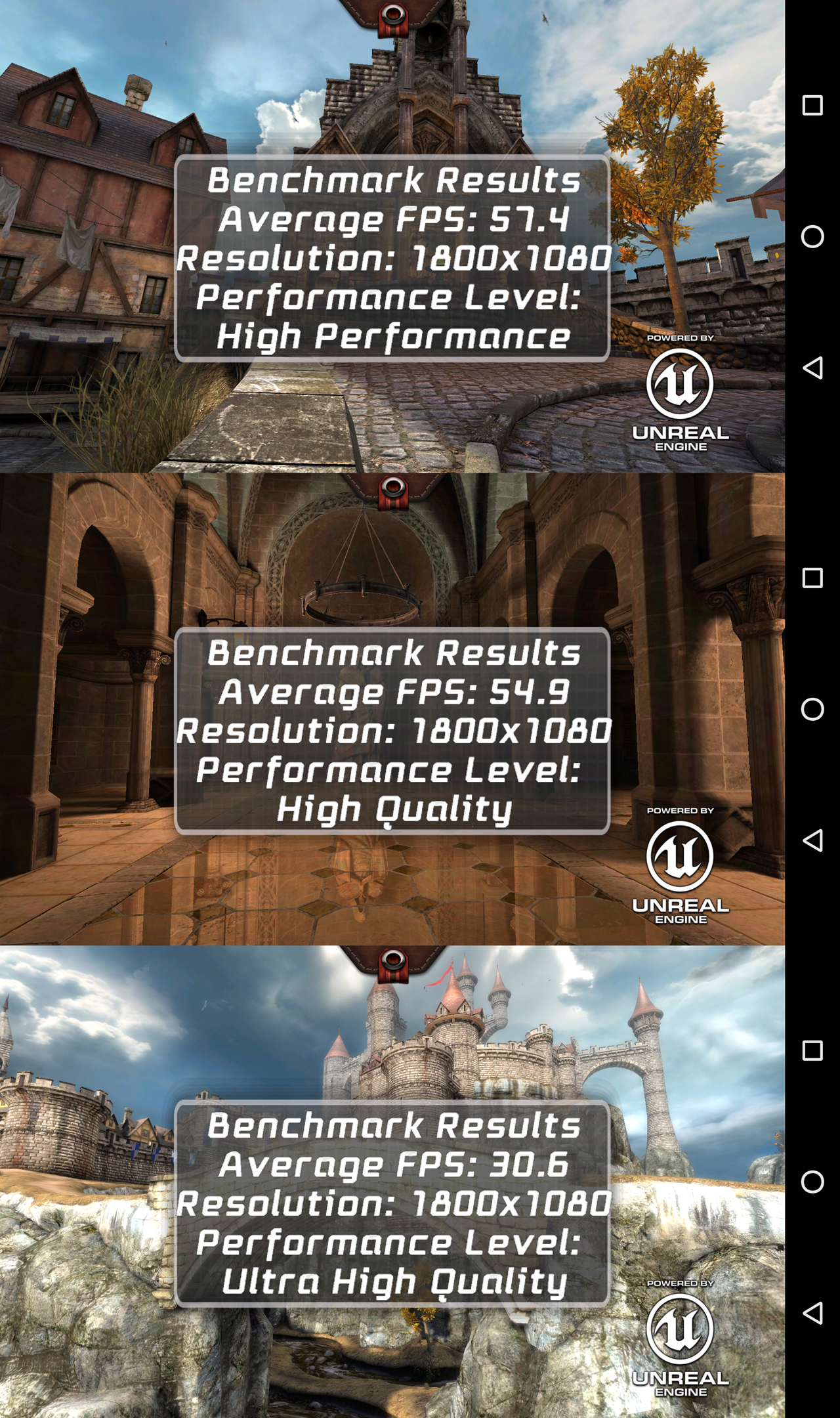
For the main High Performance and High Quality settings (performance at the expense of quality and vice versa) of the Epic Citadel visual test, the results of the Moto X Play turned out to be quite at the level - 57.4 and 54.9 fps, respectively. But for the Ultra High Quality setting, at the same resolution of 1920x1080 pixels, the frame rate dropped quite significantly (30.6 fps).
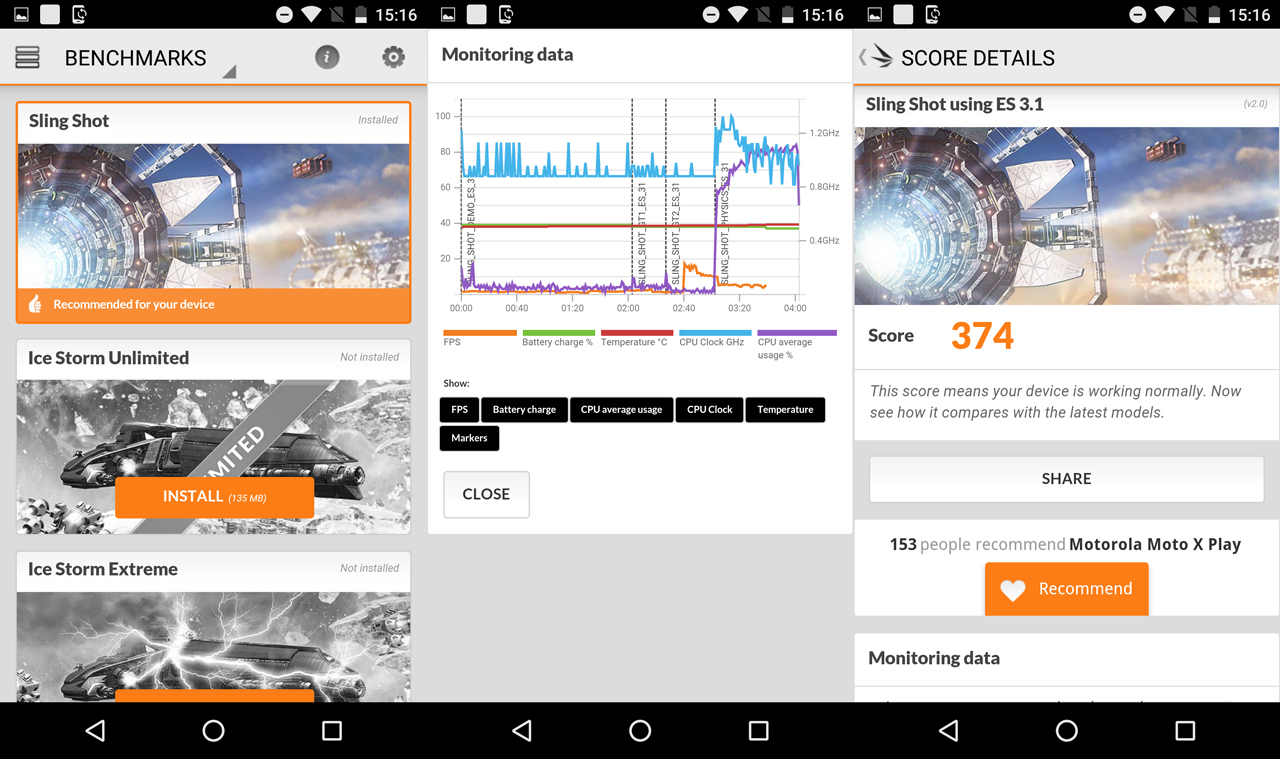
On the 3DMark universal gaming benchmark, where the smartphone was tested on the recommended Sling Shot set, a result corresponding to the average level of the platform was recorded - 374 points. Quite confidently, Moto X Play copes even with 3D games (for example, with the same Asphalt 8 races or Dead Trigger 2 shooter), but, as a rule, not at maximum settings.
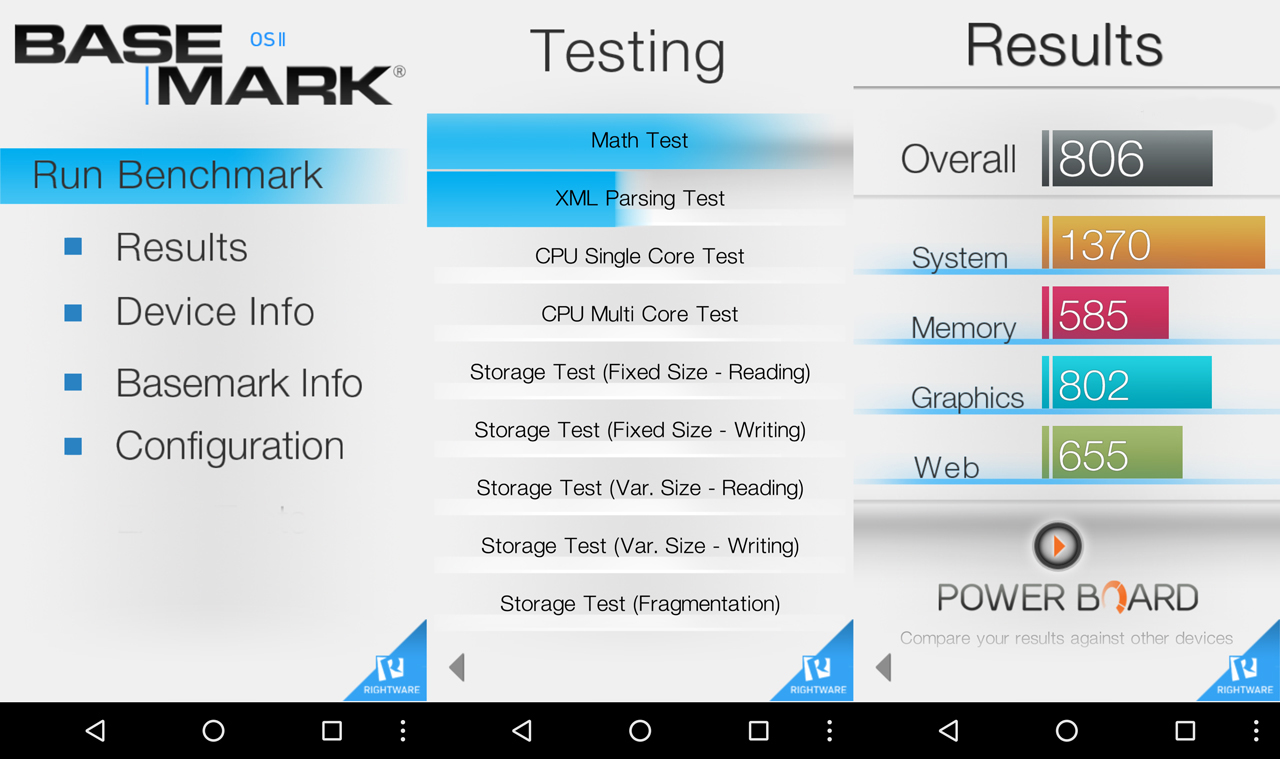
The total number of points earned by the smartphone on the Base Mark OS II cross-platform benchmark was 806.
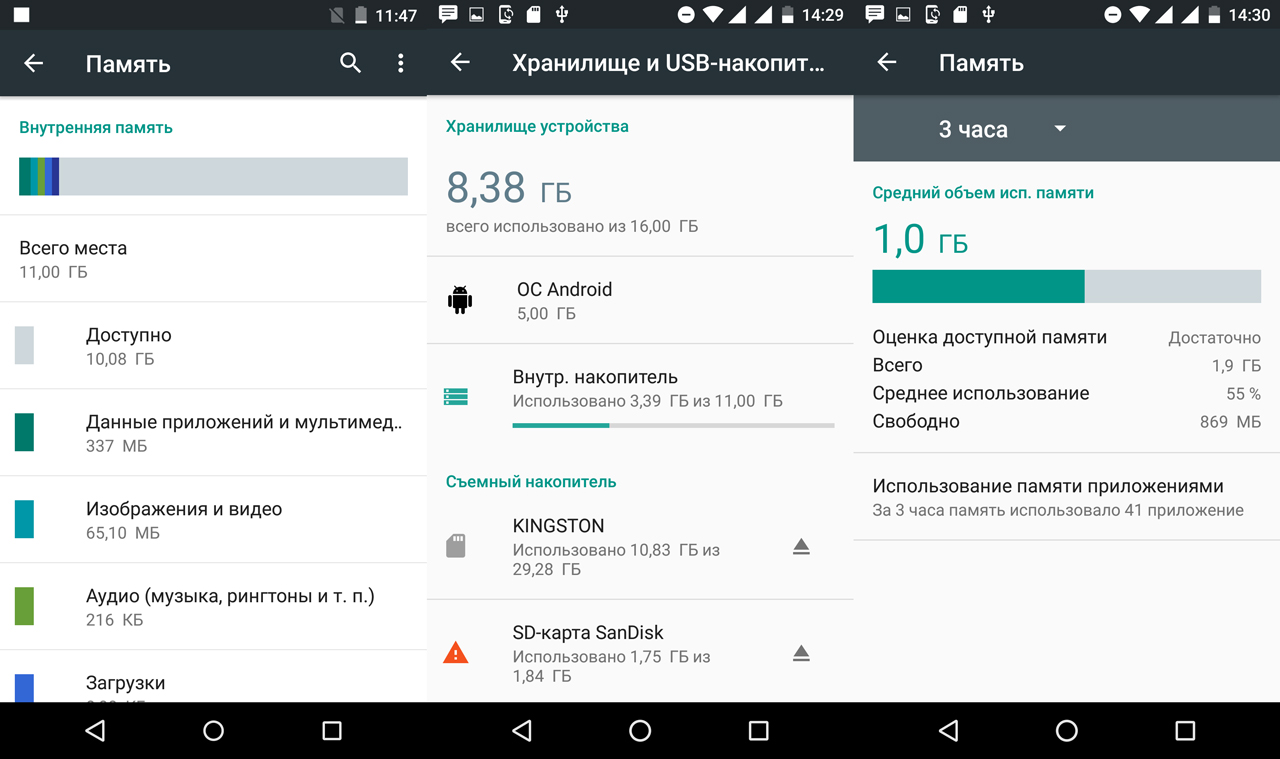
Of the 16 GB of internal memory of the smartphone, approximately 11 GB are available, and about 10 GB are initially free. You can expand the available storage with a microSD/HC/XC memory card up to 128 GB by installing it on the appropriate side of the tray in the combo slot. Once again, we note that this happens without prejudice to the installation of both subscriber identification modules (in nanoSIM format) on the other side of the tray. In addition, thanks to the support of USB-OTG technology, it is easy to connect a USB flash drive to Moto X Play as a drive.
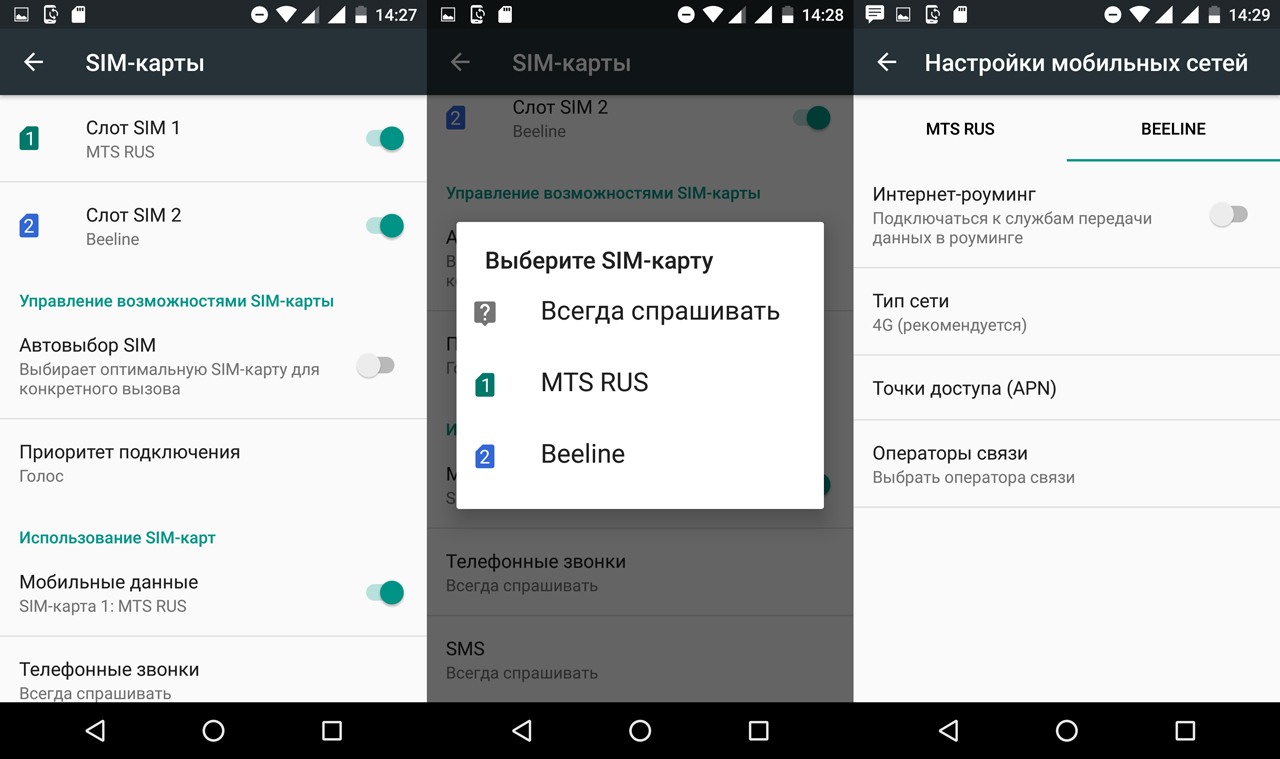
Two nanoSIM (4FF) subscriber identity modules working with one radio module provide Dual SIM Dual Standby. Both trays in the slot support 4G networks, but only one of the installed SIM cards will work with an LTE modem (Cat. 4, up to 150 Mbps). At the disposal of the other, at the same time, 2G (GSM) networks will remain. The choice of a SIM card for voice calls, SMS and mobile data transmission remains in the user's prerogative. Among the rather impressive number of available frequency ranges of the LTE-FDD Band (1, 3, 5, 7, 8, 19, 20, 28) was the "Russian troika" - Band 3 (1,800 MHz), Band 7 (2,600 MHz) and Band 20 (800 MHz). Among other wireless communications, the novelty has Bluetooth 4.0 LE + EDR interfaces, 2-band Wi-Fi a / b / g / n (2.4 and 5 GHz), as well as NFC, which is usually uncharacteristic for the middle class.
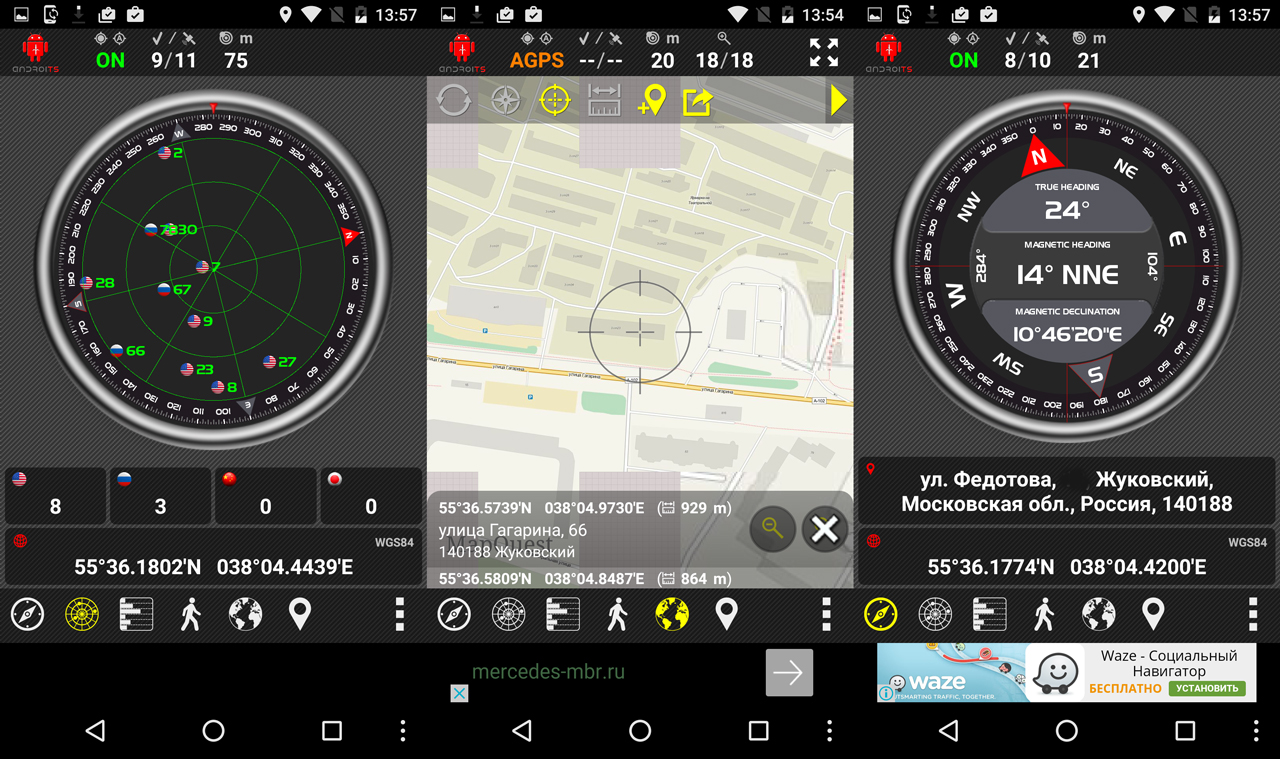
GPS and GLONASS satellite systems are used to determine the location and navigation, which is confirmed by the testimony test program Android GPS Test. Wi-Fi coordination and cellular networks possible due to the support of A-GPS technology.
"Secret of longevity" Moto X Play - in non-removable lithium-ion battery with a capacity of 3,630 mAh. The manufacturer indicates that under certain conditions offline time smartphone can work up to two days. The standard power adapter has two USB connectors, which, in principle, allows you to charge two devices from it at the same time. However, it is not recommended to do this together with a smartphone, since the process of filling its battery takes an unreasonably long time (more than three hours) anyway - after all, the maximum output current of the adapter is just over one ampere (1150 mA). Note that the fast charger (TurboCharger) must be purchased separately. It is said to be able to fill a completely discharged battery with enough energy for 8 hours in 15 minutes. battery life.
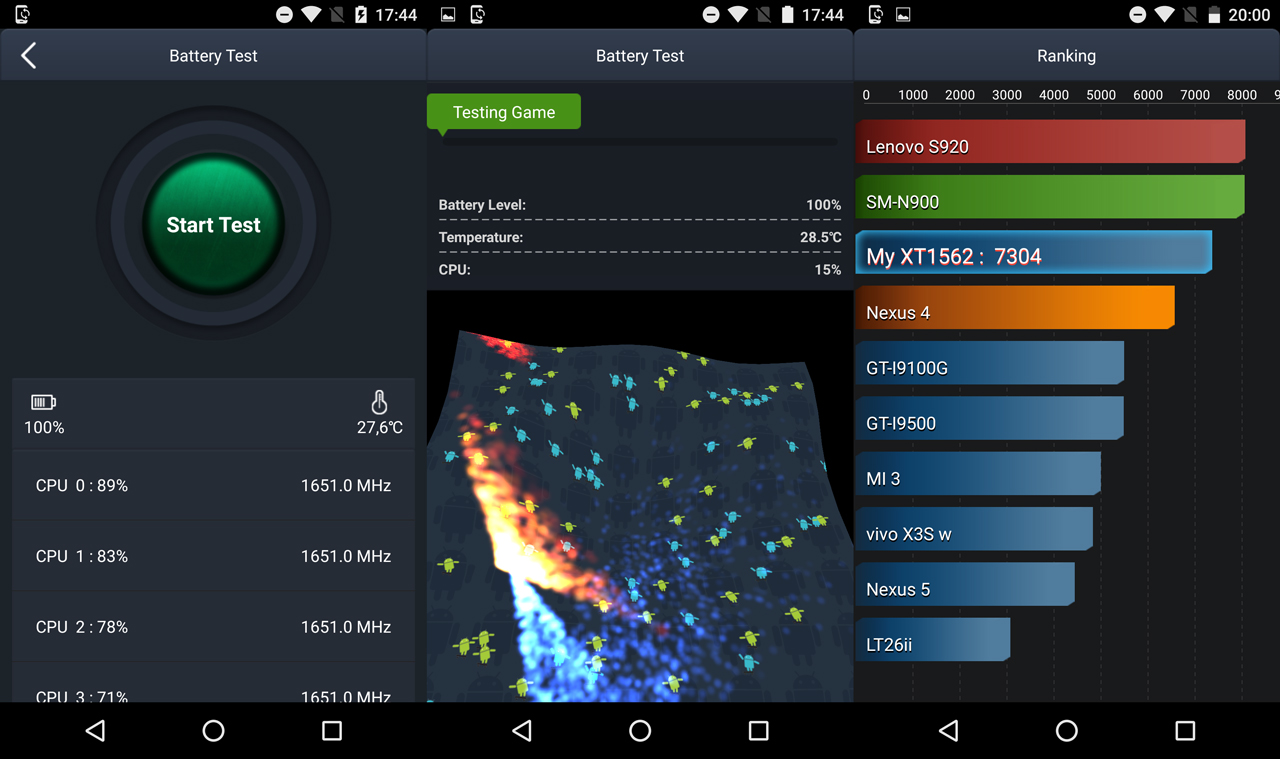
On battery tests AnTuTu Tester, the device earned 7,304 points. At the same time, every hour of playback of test videos in MP4 format (hardware decoding) and Full HD quality at maximum brightness reduced the battery charge by an average of about 10% (8 hour evaluation interval).
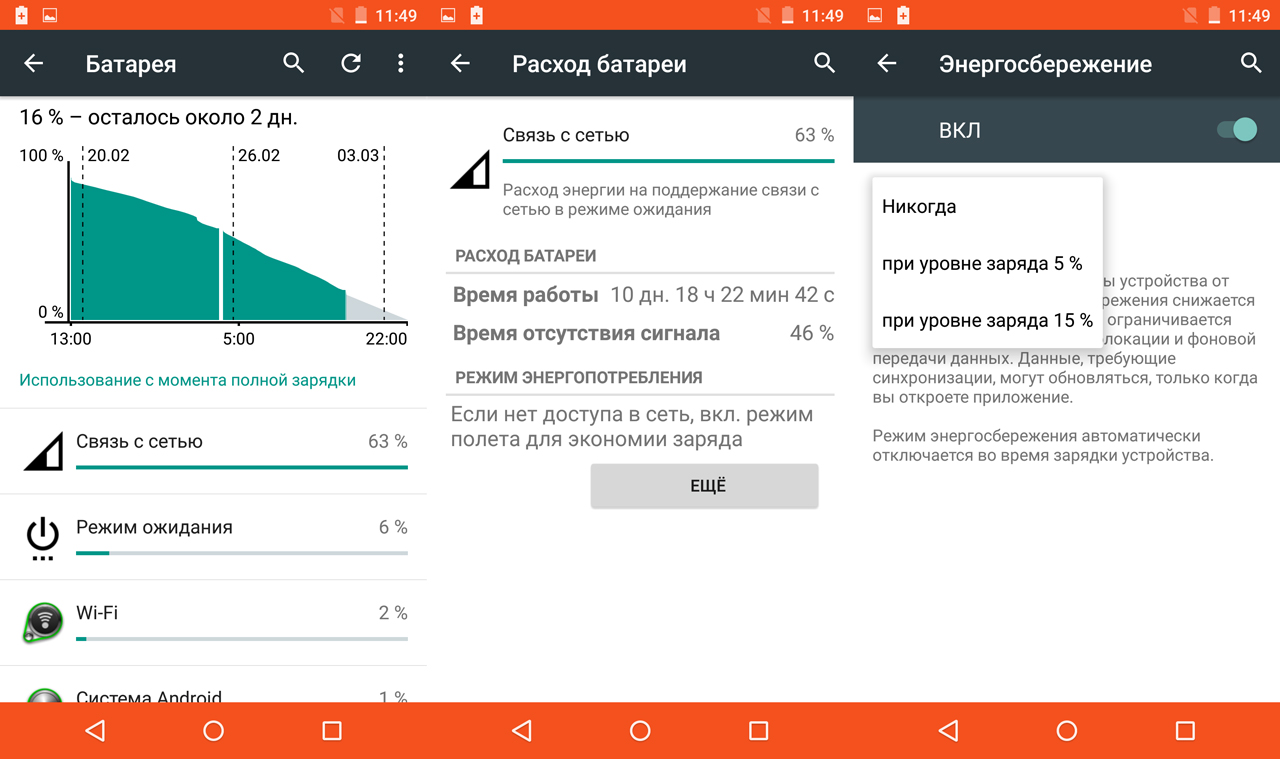
The transition to power saving mode can be programmed in the settings when the battery level is 5% or 15%.
Software Features
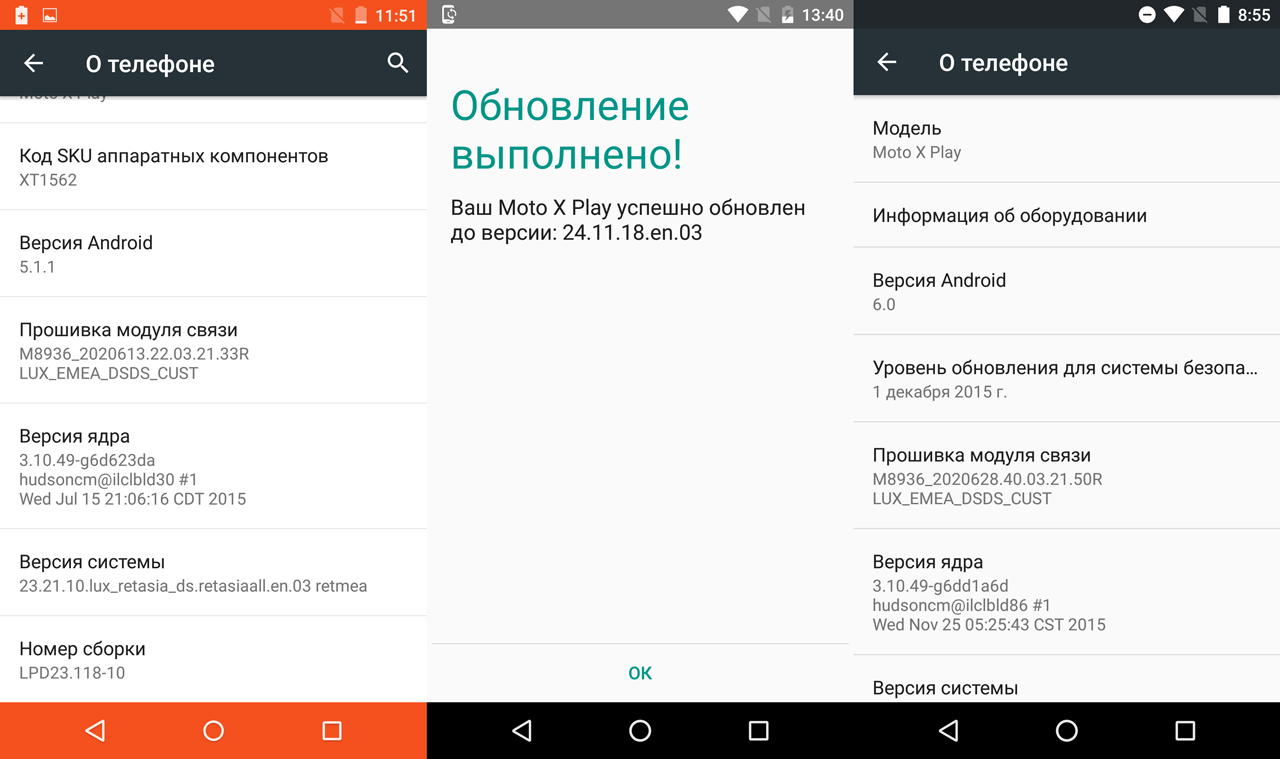
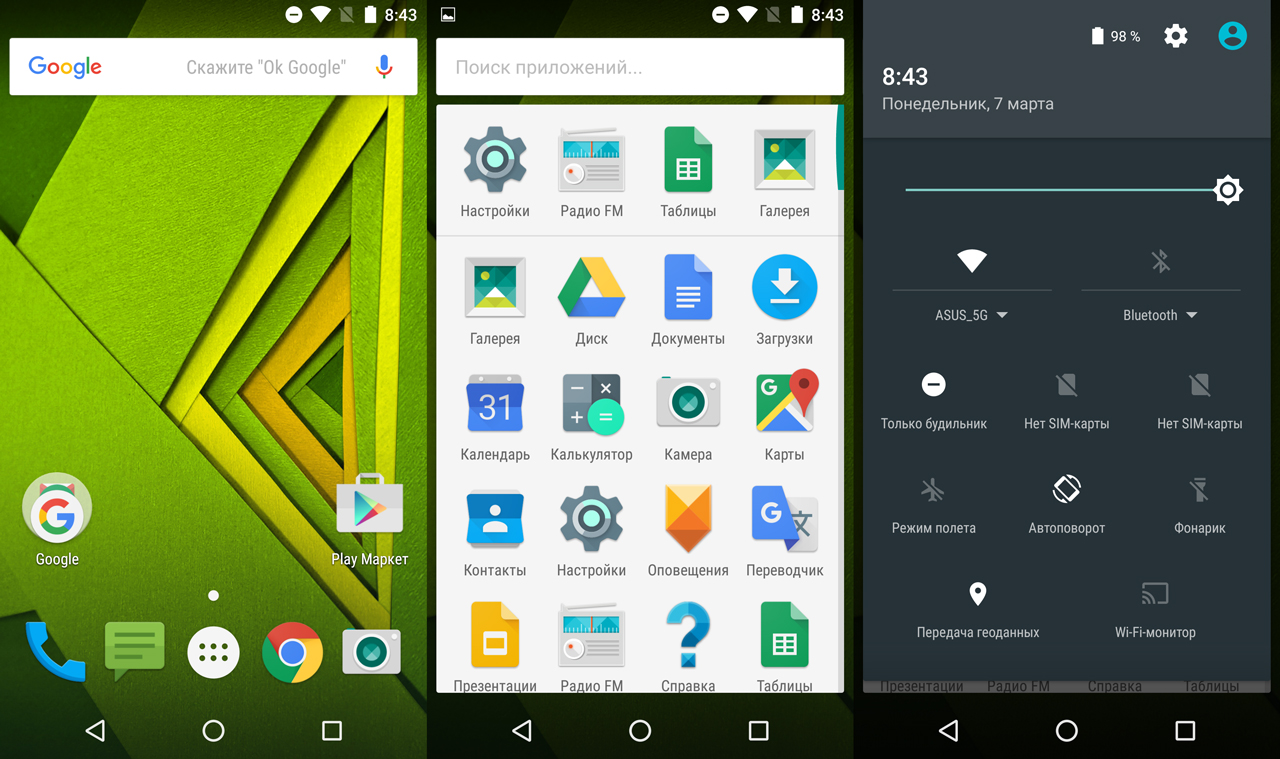
Right during testing, Moto X Play offered to update the operating system with installed android versions 5.1.1 (Lollipop) to Android 6.0 (Marshmallow). The interface of this OS is familiar enough.
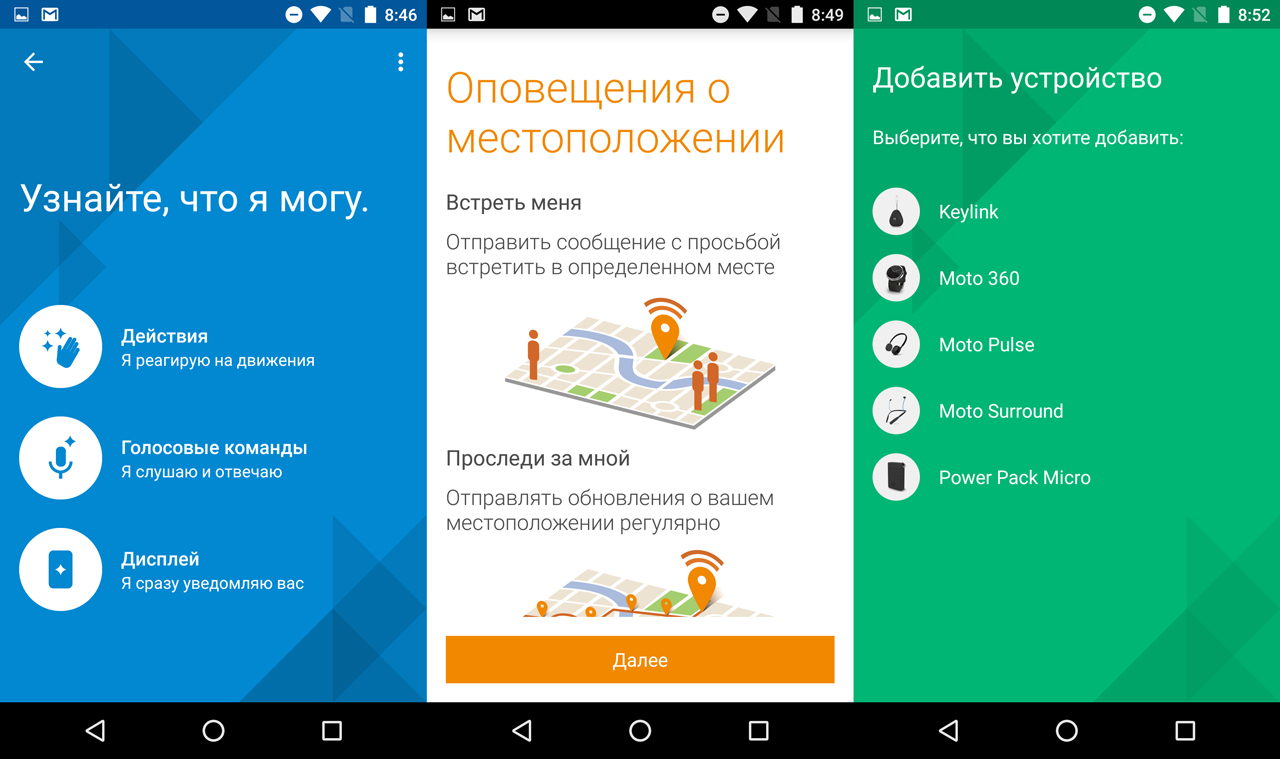
As you know, in "pure" Android there is nothing superfluous, but necessary software from Google Play you can install it yourself. Among the branded pre-installed applications, it is worth noting the Moto program, which takes care of actions (reaction to user movements), voice commands(Russian language, alas, is not supported) and notifications displayed on the display. In turn, the Alerts app lets you feel safe by sharing your location with family and friends. But to connect Motorola accessories (watches, headphones, etc.) to Moto X Play, the Connect program will help.
Purchase, conclusions
The Moto X Play smartphone can undoubtedly be attributed to the most interesting representatives of the middle price segment. According to Yandex.Market, in large retail chains, at the time of testing, they asked for 29,990 rubles. For this money, a device under a well-known brand with an original design and high-quality components is offered. Note that the color of the new device changes easily and quickly, thanks to replaceable plastic panels, and the water-repellent nano-coating of the case protects the device from accidental drops and splashes. A high-quality 5.5-inch display is adjacent to the Moto X Play with a flagship 21-megapixel camera and a fairly capacious battery. At the same time, the hardware stuffing is seasoned with "clean" Android and useful applications Motorola.
Unfortunately, the novelty cannot boast of record performance. In addition, the good autonomy of the smartphone is associated with a long process of filling its non-removable battery. large capacity. After all, a fast charging adapter is not included in the Moto X Play kit, alas.
Compared to Lenovo's other stylish longevity - - new smartphone turned out to be a little thicker (9.9 mm vs. 10.9 mm), but lighter (169 g vs. 189 g), and in terms of filling it only wins with the resolution of the main camera (21 MP vs. 13 MP), yielding, in particular, to battery capacity ( 3,630 mAh versus 5,000 mAh) and the lack of a fingerprint scanner. Not available at the time of testing. However, Lenovo believes that each of the Vibe and Moto lines (and, therefore, the models in them) has its own audience.
Review results Moto smartphone X play
Pros:
- Change body color with interchangeable panels
- Quality display
- Advanced 21 megapixel camera
- Good autonomy
- Water-repellent body coating
- "Pure" Android
Minuses:
- Average performance
- Non-removable battery
- Long process of filling the battery from a standard adapter
- The package with a smartphone does not include a device for fast charging (TurboCharger)
When Motorola left Russia 6 years ago, the American brand was forgotten. Former RAZR V3 owners switched to iPhones, and those who don't like iOS go for an Android smartphone.
And then Motorola comes back to us with several phones. I note that Moto X Play, which is dedicated to the review, debuted last summer. So, by the standards of smartphones, this is not an old man, but not the first freshness.
When you don't care about work time
The smartphone received a 3630 mAh battery, it works quietly for 2-3 days. Is it possible to discharge in a day? Yes, if you play a lot, use navigation or do not get out of social networks.
The main feature of Moto X Play is a long battery life.

Included with the phone is Charger With two USB ports, it powers two gadgets at once. But Moto was greedy and did not give the Power Charger, which is 2 times more powerful than the standard unit: 2A versus 1A. So either buy extra, or try a charger from Sony, Samsung or another manufacturer that also supports fast charging. I like it: 1.5 hours and the battery is charged.
Everything for communication
Moto X Play has two nanoSIMs, LTE and good reception. The smartphone was remembered for its very loud ringing speaker and high-quality voice transmission. If you call a lot and like to communicate by voice rather than messages, then Moto is good in this regard.
And here it is difficult not to feel the vibration signal. I forget to turn off the silent mode, so the hum of a mighty motor in my pocket helps me not to miss calls.
Picture you want to touch
The screen is bright, the picture is as alive, the image is no worse than in the iPhone 6 Plus. 2.5D Gorilla Glass 3 curved at the edges, good oleophobic coating and large diagonal. 5.5 inches, 1920x1080 pixels.

Quirky Camera
Moto has a peculiar menu, that's the problem. To focus, drag the circle while holding it with your finger, and only then press on the screen, then the phone takes a frame. Why make it so complicated, I don't understand.
The phone takes good pictures during the day, but in the evenings or indoors there are already problems. If you need a cool camera, then add 3-5 thousand and buy yourself an LG G4 or samsung galaxy S6.












Do you have 4.4.? And here is 6.0
During testing, Moto X Play managed to upgrade from Android 5.1 to 6.0. There is no difference in design, but Moto is among the first manufacturers to issue fresh firmware, thanks for that.
The smartphone does not lag or lag, although Snapdragon processor 615 is not very powerful, but 2 GB of RAM is enough for work. For a couple of weeks with a smartphone, I did not get into situations where my applications hung or slowed down. I don’t like games on phones, for this PS4 is worth it. 32 GB of internal memory was enough for me, and the card slot will help increase the useful volume.
Replaceable panels and a lot of plastic
Due to the increased capacity of the battery, the case turned out to be thick and heavy. But the back of the smartphone is curved, the smartphone does not look like a square brick. Although colleagues from the iPhone 6 Plus unanimously said that Moto X Play is too thick and uncomfortable. Apple cultists, this smartphone is not for you.
The Moto X Play has the same screen size as the iPhone 6 Plus, but the Moto is smaller and lighter.


The sides of the phone are so shiny that it seems like a metal finish. In fact, only the insert next to the camera lens is made of metal. And since the case is plastic, the assembly is dense and monolithic. In the kit we get two interchangeable covers, change the design of the smartphone according to your mood: in addition to the standard black, there are also blue and purple ones. And if you chose a white phone, then you will have green and orange.
Chips
- You can immediately hold a memory card and two SIM cards in the phone, this is not found everywhere.
- Old school FM radio works
- The smartphone reacts to movements, you lift it from the table, and new notifications are visible on the screen.
- Claimed to be splash-proof, although swimming with a phone is contraindicated.
- There are no headphones included, I listened to the phone paired with my UE 900 and I liked the sound.
Opinion
Moto - for connoisseurs, although I would not buy myself a Play, I like the Style with leather and wood inserts, but it is even more expensive. And the X Play is obscenely expensive for a mid-range smartphone, but at the same time there is no kilfichi that would be worth overpaying for.
Moto X Play is sold for 29,990 rubles, which is expensive. I won't recommend an iPhone 5s for the money, but with that kind of budget, there are plenty of options. If you want a thin and glass body, take the Samsung Galaxy A7 (2016). Honor 6 Plus is sold for 25 thousand, it costs 22 thousand ASUS ZenFone 2.
If you add 5 thousand to the price of Moto, you can generally buy last year's flagships LG or Samsung, there is already a different alignment in terms of characteristics. In addition, you can always make a knight's move and buy a smartphone for 17-20 rubles with the same filling as the Moto X, only from Meizu or Lenovo.

Specifications
- Processor: Qualcomm Snapdragon 615 MSM8939, 8 cores, 1.7 GHz
- System: Android 6.0 Marshmallow
- Memory: 2 GB RAM, 32 GB permanent, microSD card slot up to 64 GB
- SIM: 2 Nano SIM cards
- Screen: 5.5 inches, 1920x1080, 403 ppi, IPS, 10-point multi-touch
- Colors: black, white
- Camera: rear 21 MP (flash, autofocus, Full HD video recording), front 5 MP
- Sound: One front speaker
- Protection: P2i water-repellent coating
- Sensors: accelerometer, proximity sensor, light sensor, E-compass, vibration sensor, Hall sensor
- Network: GSM 850, 900, 1800, 1900, UMTS 850, 900, 1800, 1900, 2100
- Navigation: GPS/GLONASS
- WLAN: Wi-Fi 802.11 a/b/g/n
- Bluetooth: 4.0
- Battery: 3630 mAh
- Dimensions: 148 x 75 x 8.9-10.9mm
- Weight: 169 grams
Photo gallery


The AndroidLime editor received a device from the legendary Motorola company for testing, which returned to Russian market. We arranged a photo session and wrote a full review.
Traditionally, we will start with general technical characteristics, which we will consider in more detail later.
Iron
- Snapdragon 615 octa-core processor (1.7 GHz).
- Graphics accelerator Adreno 405.
- The amount of RAM - 2 GB, ROM - 16/32 GB, depending on the modification; support for microSD cards up to 128 GB.
- IPS-display with a diagonal of 5.5 inches, resolution - 1080 x 1920 pixels, pixel density - 403 ppi, screen / body ratio - 74%.
- Primary Camera: 21MP resolution, f/2.0 aperture, phase detection autofocus, dual LED flash, HDR support and face detection.
- Front camera: 5 MP, f/2.2 aperture.
- The battery is non-removable: 3630 mAh.
- Connectivity: LTE (4G), NFC, Wi-Fi, Bluetooth, FM radio.
- Support for two active nanoSIMs.
- Dimensions: 75 x 148 x 10.9 mm. Weight - 169 grams. Waterproof case (IP52).
- Release date: July 28, 2015.
- Price: 30 thousand rubles (as of March 22, 2016).
Equipment
The gadget arrived in a cardboard box, inside which we found:
- smartphone;
- two additional back covers (we'll talk about them later);
- charging cord and power supply with two USB connectors for charging two gadgets at once;
- branded clip to remove the SIM-card tray;
- documents and instructions.

Everything is great, but where are the headphones? They don't and never will, unfortunately.
Design
X Play is available in two color options: white and black. We got a white model for testing.
The upper edges of the device are rounded. On the front panel, at the top of the screen, is front-camera, earpiece, proximity and ambient light sensor. Below the display is a large main speaker - aesthetically, it spoils the design, although this is a matter of taste. The control buttons are touch-sensitive, located on the display.


There is no notification indicator, it is replaced by a special function. It displays information on the screen that is off, if you take the smartphone in your hand.
The left side is empty, on the right there is a ribbed power button and a smooth volume rocker. The first is located in such a way that it is convenient to use it, holding the device in one hand - the thumb naturally rests on the button.

On the top panel there is a 3.5 mm headphone jack and a tray for SIM-cards and memory cards, on the bottom - microUSB for charging and connecting to a computer. It is noteworthy that a separate place is allocated for the memory card, and when using it, you will not have to give up the second SIM card.
The rear panel placed the camera, LED flash and a round logo of the manufacturer. These elements are located on a silver rectangle with rounded edges.

Rear part The device has a rounded bend characteristic of the line. Due to this, the thickness of the device ranges from 8.9 to 10.9 mm.

Now to the most interesting. A distinctive feature of Motorola smartphones is the rear panel. First, it is removable and available in different colors. On the official website of the company, there are 14 options to choose from, but this option is not available for buyers from Russia. Where to buy removable covers for Moto X Play? Of course, on Aliexpress.

Secondly, the cover is made of rubberized plastic (soft-touch), which immediately gives certain advantages: the device does not slip in the hand, is resistant to small scratches and is pleasant to the touch.

Thirdly, it does not collect fingerprints at all and is covered with an original embossed pattern.

In general, the smartphone lies comfortably in the hand, as far as possible for such sizes.


Display
The device is equipped with a 5.5-inch IPS-matrix screen with a resolution of 1920 x 1080 pixels and a pixel density of 403 ppi. The manufacturer did not pursue the heaped QHD resolution, but used the standard Full HD.

The display of the gadget deserves extremely positive ratings. The picture quality, color rendition and contrast are excellent, for a week of use there were no complaints about the picture. The maximum brightness of the screen is enough to use the device in sunny weather. Automatic setting works quickly and correctly. The viewing angles of the display are large, for everyday use this is enough with a margin.

As protection - glass Gorilla Glass 3 with an oleophobic coating. It is reluctant to collect fingerprints, and removing them is easy.

In the screen settings there is an item "Display colors", where you can choose one of two modes: normal or bright. The difference is noticeable: the first is more pale, the second is saturated.

Power
Moto X Play runs on “pure” Android 6.0 Marshmallow, Snapdragon 615 chipset (4 Cortex-A53 cores at 1 GHz + 4 similar cores at 1.7 GHz), Adreno 405 video accelerator and 2 GB of RAM. The configuration corresponds to the level of smartphones above average.

In everyday use, there are no complaints about the device - everything works quickly, smoothly and stably. Some users have complained about the “lag” of the interface, but nothing of the kind was noticed on the tested instance - Marshmallow is perfectly optimized and just “flies”. Perhaps problems will show up with the constant use of the device and clogged memory, but how to avoid this.
It is important to note that under normal loads, RAM is used by 50-60 percent. In other words, up to 900 MB remains free.

The name X Play says that the smartphone should "play". Despite not the richest configuration and low test scores (see below), the device copes well with resource-intensive games. We killed mutants in Dead Effect 2, bludgeoned enemies in and ran from zombies in Walking Dead. The games did not slow down, everything works quickly and smoothly. The only drawback is that the rear side of the gadget overheats after 10 minutes of playing, which is the case for many devices.
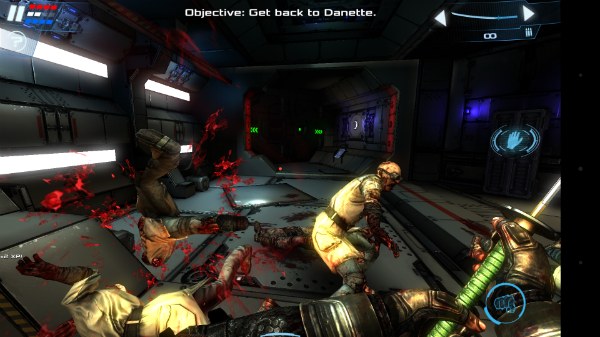

To evaluate the performance, the gadget was tested in proven benchmarks.
AnTuTu
In the most popular test, the result was just over 42,000 points. The indicator is not outstanding and is inferior to the "old" flagships Nexus 6, HTC One M9 and LG G4.

In addition, our test subject is ahead of LeTV 1S, which costs TWO times cheaper. Rhetorical question: why overpay?
Geekbench 3
In a single-threaded test, the result was 731 points, in a multi-threaded one - 2530. In the first indicator, Moto is above the Galaxy S4 and Nexus 7 (2013), but below the Nexus 5, which will soon turn 3 years old.

GFXBench
The results of testing 3D graphics are presented in the screenshots. The indicators are average and significantly inferior to the flagship devices.

Interface and memory
As already mentioned, the gadget operates on Android 6.0 Marshmallow without proprietary firmware, shells and heaps unnecessary applications. Perhaps this is one of the main advantages, because the interface works briskly and stably, which was taken care of by Google.
- Excellent display and color reproduction.
- The camera and the highest quality of photos.
- "Naked" android latest versions.
- A capacious battery that will definitely last for a day.
- I really liked the removable back cover.
- Support for two SIM-cards and microSD at the same time.
- High price - Chinese counterparts are almost twice cheaper, and the Nexus 5X at the same price wins significantly in terms of performance.
- Non-removable battery.
- There are no headphones included.
After acquisition Google division of Motorola Mobility (now "Motorola - a Google Company"), the release of Motorola Moto X was perhaps the first significant step of the veteran mobile market. For a long time The mysterious Google X Phone has been surrounded by many rumors. The situation was clarified at the D11 conference, where CEO Dennis Woodside not only confirmed the release of the flagship, but also announced that Moto X will be the first smartphone assembled in the United States. Note that it is in the United States that Moto X smartphones assembled in the United States are sold, but in other countries, such as Canada, devices assembled in China are sold.
On the first of August Motorola Moto X was officially presented, and it turned out that the details covered on the D11 are by no means the most interesting side of the device. Other features of the top-end smartphone look much more interesting. Firstly, this is an opportunity to purchase Moto X in your own design, combining various body elements. Second, built-in voice control, which is always active and awaits commands even when the screen is off.
Key Features of Motorola Moto X (XT1058)
- Single-chip system: Motorola X8 Mobile Computing System based on Qualcomm Snapdragon S4 Pro MSM8960T
- CPU: 2x Krait 300 @1.7GHz (ARMv7)
- GPU: 4 cores Adreno 320 @400 MHz
- Operating system Android 4.2.2 Jelly Bean
- Display: AMOLED, 4.7″, 1280×720, 312 ppi
- RAM: 2 GB
- Internal memory: 16/32 GB
- GSM GPRS/EDGE 850, 900, 1800, 1900 MHz communication (AT&T version)
- Communication 3G UMTS HSPA 850, 900, 1900, 2100 MHz (AT&T version)
- 4G (LTE) Bands 2, 4, 5, 17 (AT&T version)
- Bluetooth 4.0 LE+EDR
- Wi-Fi 802.11a/b/g/n/ac (2.4 + 5 GHz)
- NFC, MHL(?)
- A-GPS/Glonass
- Temperature and pressure sensors
- Rear camera: 10 MP, autofocus
- Front camera: 2 MP
- Battery: non-removable, 2200 mAh
- Dimensions: 129.4×65.3×10mm
- Weight: 132 g (weighted in editorial)
More information about the filling of Motorola Moto X can be found in our news. The 32GB flash version officially costs $530 in the US (no contract).
| Google Nexus 4 | Sony Xperia SP | LG Optimus G | HTC One | ||
| Screen | 4.7" AMOLED | 4.7" IPS Plus | 4.6″ | 4.7" IPS Plus | 4.7″ S-LCD3 (IPS) |
| Permission | 1280×720, 312 ppi | 1280×768, 317 ppi | 1280×720, 319 ppi | 1280×768, 317 ppi | 1920×1080, 469ppi |
| SoC | X8 Mobile Computing System @1.7 GHz (2 cores, ARMv7 Krait 300) | Qualcomm Snapdragon S4 Pro @1.7GHz (2 cores, ARMv7 Krait) | Qualcomm Snapdragon S4 Pro @1.5GHz (4 cores, ARMv7 Krait) | Qualcomm Snapdragon 600 @1.7GHz (4 cores, ARMv7 Krait) | |
| GPU | Adreno 320 | Adreno 320 | Adreno 320 | Adreno 320 | Adreno 320 |
| RAM | 2 GB | 2 GB | 1 GB | 2 GB | 2 GB |
| Flash memory | 16/32 GB | 8/16 GB | 8 GB | 32 GB | 16/32/64 GB |
| Memory card support | No | No | microSD | No | No |
| Operating system | Google Android 4.2 | Google Android 4.2 | Google Android 4.1 | Google Android 4.1 | Google Android 4.1 |
| SIM format | Nano SIM | Micro SIM | Micro SIM | Micro SIM | Micro SIM |
| Battery | non-removable, 2200 mAh | non-removable, 2100 mAh | non-removable, 2370 mAh | non-removable, 2100 mAh | non-removable, 2300 mAh |
| cameras | rear (10 MP; video - 1080p), front (2 MP; video - 1080p) | rear (8 MP; video - 1080p), front (1.3 MP) | rear (8 MP; video - 1080p), front (0.3 MP) | rear (13 MP; video - 1080p), front (1.3 MP) | rear (4 MP; video - 1080p), front (2 MP) |
| The size | 129×65×10 mm | 134×69×9.1mm | 131×67×9.9 mm | 132×69×8.5mm | 137×68×9.3mm |
| Weight | 132 g* | 139 g | 155 g | 145 g | 143 g |
| Average price (Y.Market) | 32 GB: T-10451529 | 16 GB: T-8490976 | 8 GB: T-9328668 | 32 GB: T-8461088 | 32 GB: T-9281443 |
| Motorola Moto X offers (Ya.Market) | L-10451529-10 | ||||
*weighted in editorial
Motorola has another model in its range, very similar in characteristics to Moto X - Droid Ultra, presented a week before our hero. Its main difference lies in the larger diagonal of the display by 0.3 inches. The resolution is the same.
And it is precisely because of the permission that we cannot put the Motorola Moto X on a par with the flagships of other manufacturers. One could turn a blind eye to a small difference in the diagonal, but when 1080p has already established itself as the standard for top models, 720p immediately throws our hero on a par with the middle class.
Equipment
Motorola Moto X comes in a white cardboard box with colorful triangles and a flip-top lid.

The smartphone package includes only the essentials: a network adapter with two USB inputs, a cable, as well as a tool for installing a SIM card and an information booklet.

The Spartan set of accessories is diluted with the presence of two USB connectors for network adapter. With an output current of 1150 mA, it is quite capable of coping with charging two batteries at once. mobile devices. You can expand the complete set of Moto X by ordering a smartphone with your own design.
Moto Maker
When buying a Motorola Moto X with an AT&T carrier contract, users can design a smartphone with their own design and equipment.

The greatest variety is provided when choosing the color of the back panel - 18 colors are available here (including two fabric textures). Then, from seven shades, the buyer chooses an "accent" - the color of the rear camera rim and mechanical keys. In addition, you can choose the color of the front panel, but here we are not spoiled - black or white.
The screen has good viewing angles. It is true that the white color at relatively large angles takes on a slight tint, but the black color is just black at any angle (although the reflection from the black areas at some angles has a blue "metallic" tint). so black that the contrast parameter in this case is simply not applicable. When viewed perpendicularly, the uniformity of the white field is excellent. Switching the state of the matrix elements is actually instantaneous, but there may be a step (or two) 16.7 ms wide at the turn-on front (corresponding to a screen refresh rate of 60 Hz). In some conditions, the presence of such a step can lead to plumes trailing behind moving objects, but in normal use it is almost impossible to see these artifacts. Rather, the opposite is true - dynamic scenes in films on OLED screens are distinguished by high clarity and even some “twitchiness” of movements.
The gamma curve constructed from 32 points did not reveal any blockage either in the highlights or in the shadows, and the exponent of the approximating power function is 2.30, which is slightly higher than the standard value of 2.2, while the real gamma curve deviates little from the power dependence:

Note that due to the dynamic adjustment of the brightness of the backlight in accordance with the nature of the displayed image (on average bright images, the brightness decreases slightly), the resulting dependence of brightness on hue (gamma curve) does not correspond to the gamma curve static image, since the measurements were carried out with a sequential output of shades of gray on the entire screen.
The color gamut is much wider than sRGB:

The spectra show that the primary colors are well separated:

As a result, the colors on this screen are oversaturated and somewhat unnatural. The color temperature balance is good: shades of gray have a color temperature close to 6500 K, which changes little over the entire part of the gray scale that matters (the range close to black can be ignored, since color reproduction is not so important in it, and the measurement error of color characteristics is high ):

The deviation from the blackbody spectrum (ΔE) is less than 10, which is considered a good indicator for a non-professional device, and also changes slightly from shade to shade:

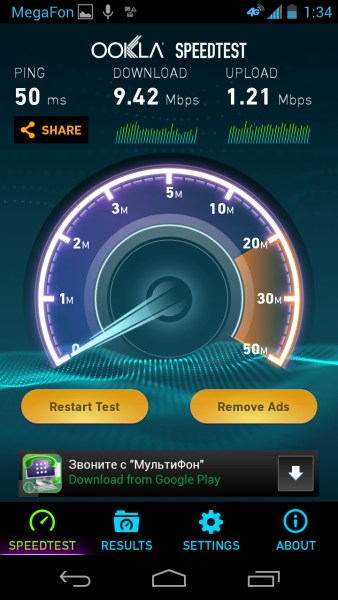
Above is the best internet connection test result that we got in places with excellent LTE reception in the Megafon network. The ping value and transfer rate clearly do not correspond to the 4G LTE range; at best, it's HSPA+. Further searches on the Web confirmed that the frequency of 700 MHz for Russian LTE is not yet available, and at best in our country we can hope for HSPA +.
 |  |
For calls and SMS, Moto X uses the standard Google interface. It is complemented google apps People and AT&T. The reception quality is good, we did not notice any sudden "drops" from the network during testing. Crystal Voice technology and two almost imperceptible microphones are responsible for the quality of communication. They do their job very well.
The list of wireless communication protocols also includes dual-band Wi-Fi, which works not only in standard b / g / n protocols, but also ac. Unfortunately, in our office, the smartphone did not see the 5 GHz network; it seems to support other channels. The connection speed of 2.4 GHz shows that the smartphone has one antenna for Wi-Fi, operating in single-channel mode. In addition, the assets of Motorola Moto X GPS support and Glonass, as well as NFC.
Camera
Motorola Moto X is equipped with two cameras. The front has a resolution of 2 MP (1920 × 1080). You can check out a sample of her photo below:

The 10 MP rear camera is activated with a gesture that is complex enough not to accidentally trigger in your pocket - you need to turn your wrist twice and return it to the previous position. At the same time, the smartphone will emit an increasing vibration signal.
The list of camera options is short: HDR, flash, manual focus and panoramic shot. They appear if you move the screen to the right. The opposite gesture opens the gallery. Up and down movements are responsible for the zoom; 4x is the maximum.

Anton Solovyov commented on the operation of the Motorola Moto X camera:
 | Many of the inscriptions are quite readable. In general, the fore and middle grounds worked out well. |
 | V HDR mode the camera does not bring the pictures very evenly, so the sharpness “walks” randomly around the frame field. However, the numbers of the nearest cars are clearly distinguishable. |
 | To distant plans, the sharpness drops a little. |
 | The effect of walking sharpness is especially good in the camera in low light, although in general the picture does not look so bad. |
 | But at good lighting the camera copes normally, the noise appears only in the shadows in the background. |
 | There is no drop in sharpness towards the edges, but sharpness in the center is not so good either. |
 | Macro shooting in low light is spoiled by noise. |
 | The flash improves things a lot. |
 | The text is worked out well, without noticeable damage. |
 | Night shots are good enough for the camera. |
In addition to "field conditions", we also tested the camera in the lab:
≈1300 lux. The camera performs relatively well. |
|
 | ≈460 lux. When shooting finely detailed objects, the camera is already losing a lot. |
 | ≈240 lux. Contrasting objects still work out well, but everything else is spoiled by strong noise. |
 | ≈240 lux, flash. The flash allows you to achieve the original resolution. |
 | |
 |

The camera turned out to be quite balanced. She is not outstanding, but there are no significant failures in her work. The program as a whole works reasonably, however, colored noise is noticeable in places, suppressed only by half. In some places, it even recycles, as a result of which, when lighting deteriorates, the camera demonstrates an improvement in resolution. However, these are only numerical results; visually, the resolution drops very quickly.
The camera module is clearly not the best, as evidenced by the results of shooting the stand, but the optics and the matrix are quite consistent with each other. Special attention deserves the work of the flash, which copes well with its task even in macro photography.
Perhaps the camera is not so bad, especially if the requirements for it are low. It is suitable exclusively for documentary shooting, and when shooting texts and macro in low light, do not forget about the presence of a good flash.
Motorola Moto X is capable of shooting video, and in two modes - normal (MPEG-4 AVC video ( [email protected]), 17.1 Mbps, 1920×1080, 29.929 fps; sound AAC LC, 128 Kbps, 48 kHz, 2 channels) and slow motion, no sound (MPEG-4 AVC ( [email protected]), 5002 Kbps, 1280×720, 15,000 fps). The video quality is at a good level, the camera adapts well to lighting conditions and demonstrates a good fps level.
Software
Motorola Moto X runs on Android 4.2.2 operating system. We tested an unlocked version of the AT&T operator with the latest firmware version at the time of this writing, 139.12.54.ghost_att.ATT.en.US. By the way, recently it became known that Google is preparing for Moto X android update 4.4.
 |  |
Motorola didn't add much variety to the operating system. In addition to a wide range of standard OS creator programs, the smartphone has only a few Motorola and AT&T utilities on board. Among them, we note Motorola Assist. It puts the phone into a customizable Meeting mode (if available on the calendar), Driving mode (if the GPS is signaling active movement), and Sleep mode (at a set time every day).
 |  |
By default, 26.33 out of 32 GB of phone memory is available to the user. In relative terms, this may not be too small, but the fact that the mobile OS takes up more than 5 GB is not encouraging. It will be difficult to improve the situation, since root rights are not granted to the user. Turning on the phone takes approximately 20 seconds.
There is no Russian in the list of available system languages, but on the Web you can already easily find instructions for Russifying a smartphone.
Voice control, active display and PC integration
Let's move on to the most interesting. Motorola Moto X along with Droid Ultra, Mini and Max supports Touchless Control - control the phone with your voice, including when the screen is off.
The Touchless Control function is activated by the phrase “OK Google Now”, which must first be recorded in order for the smartphone to recognize your command.
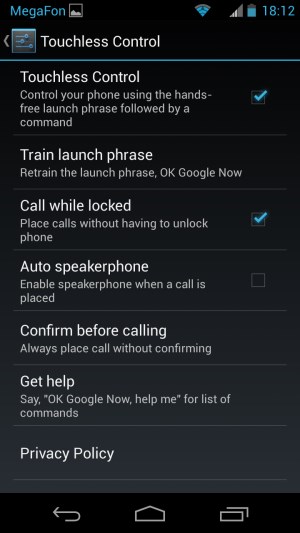 |  |
The set of commands perceived by the phone is very extensive, and the phone sensitively picks them up. We had no problems with recognition within the same room. Perhaps the voice is easily picked up from the next room, but the change in timbre does not allow Moto X to determine the phrase heard as a key one. In conditions of normal hearing, the smartphone determines the owner’s timbre well and responds to the voice, even if the command was pronounced a little differently. But it’s not so easy to deceive a smartphone: during testing, ten people unsuccessfully tried to do this.
Recognition is not perfect, but generally good. Alas, Touchless Control does not understand Russian: now the list of supported languages includes American versions of English and Spanish, Canadian version of French and Brazilian version of Portuguese. But the application is constantly updated, learning at least new commands. For example, in the latest version at the time of writing, the smartphone has learned to understand the replica “Find my phone”, in response to which it starts to give shrill signals.
 |  |
Touchless Control requires a network connection, of course. And if you also take into account that the microphone is always on in this mode, power consumption immediately becomes a burning issue. In the corresponding section, we will definitely evaluate how wireless control affects the duration of the smartphone.
Due to the fact that AMOLED matrices consume little power when displaying black, Moto X uses a display instead of LEDs for notification in sleep mode. This function is called appropriately - Active Display. While in sleep mode, the smartphone periodically displays the time, and with it the icons of events that deserve attention. In the Active Display settings, you can limit the list of applications that can send alerts in this way.
Active Display also uses the phone's sensors. As a result, time and alerts pop up on a black display only when the user picks up the phone. The indication works quickly, even before the finger reaches the unlock button.
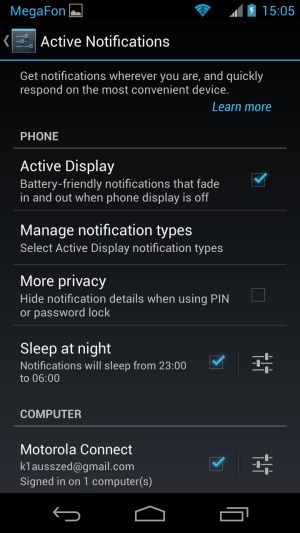 |  |
The Active Display settings hide the third know-how that deserves no less attention - Motorola Connect. It allows you to view call and SMS history through the Chrome extension, send messages, and receive sound and graphic pop-up notifications for incoming calls and SMS. Of course, for Motorola Connect to work, you need to sign in to the same Google account via android and Chrome browser on PC.

By the way, if the capabilities of Motorola Moto X are impressive, but for some reason you are not going to buy it, some special features of the novelty can be obtained on another Android smartphone.
Performance
The Motorola Moto X is based on the Motorola X8 Mobile Computer System platform. It consists of three elements:
- Qualcomm Snapdragon S4 Pro MSM8960T SoC:
- CPU: 2x Krait 300 (ARMv7) @1.7GHz
- GPU: 4 cores Adreno 320 @400 MHz
- Processor for contextual computing, working with sensors and camera, but in idle mode capable of taking over the functions of the main processor
- A natural language processor that works with sound and, in particular, with noise reduction and voice control
 |  |
We encountered a similar filling when Sony testing Xperia SP - the only difference was the lack of an additional pair of processors. And RAM Sony smartphone was two times smaller.
Let's move on to benchmarks:
Synthetic tests show that Motorola Moto X outperforms mid-range smartphones based on similar platforms. Based on the fact that in Geekbench 2, which does not use graphics, the advantage disappears, we can assume that the additional processor of the Motorola platform is involved in the corresponding scenarios.
 |  |
We also tested the Moto X in other versions of the above benchmarks. So to speak, for the future.
Antutu 4 Benchmark:
 |  |
Antutu X Benchmark:
 |  |

In new benchmarks, we compared the Moto X to several competitors based on Qualcomm's more advanced platform, the Snapdragon S4 Pro APQ8064. Despite the fact that they all have twice as many cores, the Motorola smartphone is second only to them in Geekbench 3.
In the MobileXPRT test suite, we also pitted the Moto X against the Samsung Galaxy Note 3 N900, which is vastly more powerful than our hero. Logically losing in performance tests, Motorola snatched victory in the work with the interface. The status of "a Google company" is obvious.
 |  |
Let's move on to gaming benchmarks. Here, for a more revealing comparison, we included the top-end LG G2 based on the Qualcomm Snapdragon 800 platform:
| (Qualcomm MSM8960DT) | Sony Xperia SP(Qualcomm MSM8960T) | LG Optimus G(Qualcomm APQ8064) | LG G2(Qualcomm Snapdragon 800) | |
| 3DMark Ice Storm (more is better) | Maxed out! | 10256 points | 9439 points | Maxed out! |
| 3DMark Ice Storm Extreme (more is better) | 6814 points | - | - | 9831 points |
| 3DMark Ice Storm Unlimited (more is better) | 10656 points | - | - | 15809 points |
| Epic Citadel High Performance | 59.3 fps | 57.8 fps | 56.7 fps | 56.7 fps |
| Epic Citadel High Quality | 58.9 fps | 56.6 fps | 56.3 fps | 56.3 fps |
| Epic Citadel Ultra High Performance | 58.0 fps | 52.7 fps | 45.4 fps | 51.3 fps |
Yes, from the Epic Citadel test modern smartphones are gradually growing. But note that the Moto X outperformed the LG G2 in it, and even in the most difficult mode it did not reach the VSync frequency by just 2 fps. It will be much more interesting to look at the results of the demanding T-Rex HD scene:
| LG Optimus G | HTC One | Samsung Galaxy Note 3N9005 | ||
| GFXBenchmark T-Rex HD (C24Z16 Offscreen) | 15 fps | 8.3 fps | 15 fps | 26 fps |
| GFXBenchmark T-Rex HD (C24Z16 Onscreen) | 26 fps | 11 fps | 13 fps | 26 fps |
| GFXBenchmark T-Rex HD (C24Z24MS4 Onscreen) | - | - | - | - |
| GFXBenchmark T-Rex HD (C24Z16 Fixed time Offscreen) | 14 fps | 8.0 fps | 14 fps | 25 fps |
| GFXBenchmark T-Rex HD (C24Z16 Fixed time Onscreen) | 24 fps | 10 fps | 13 fps | 25 fps |
| GFXBenchmark Egypt HD (C24Z16 Offj screen) | 41 fps | 21 fps | 37 fps | 68fps |
| GFXBenchmark Egypt HD (C24Z16 Onscreen) | 51 fps | 29 fps | 33 fps | 54 fps |
To recap, the Moto X at its 720p resolution is capable of delivering the same number of frames per second as the mighty Samsung at its top Snapdragon 800 at 1080p.
Browser testing was done on Chrome as there are no other browsers installed on the Moto X. In the competition on the same platform, the standard Android browser suffers a crushing defeat:
In conclusion, let's try a couple of games: dynamic slasher Dungeon Hunter 4 and demanding racing simulator Asphalt 8. No problem.

Video playback
Despite the fact that on some resources on the Web there is a mention of the presence of an MHL interface, we did not find it or Mobility DisplayPort in this smartphone, but perhaps we needed to make more attempts. As a result, I had to limit myself to testing the output of video files on the screen of the device itself. To do this, we used a set of test files with an arrow and a rectangle moving one division per frame (see "Methodology for testing video signal playback and display devices. Version 1 (for mobile devices)"). Screenshots with a shutter speed of 1 s helped to determine the nature of the output frames of video files with different parameters: the resolution varied (1280 × 720 (720p) and 1920 × 1080 (1080p) pixels), as well as the frame rate (24, 25, 30, 50 and 60 frame/s). In tests, we used the MX Player video player in the "Hardware" mode, since the "Hardware +" mode did not work quite correctly. The results of this test are summarized in the table:
| File | Uniformity | Passes |
| watch-1920x1080-60p.mp4 | not playable | |
| watch-1920x1080-50p.mp4 | Badly | lot |
| watch-1920x1080-30p.mp4 | Great | No |
| watch-1920x1080-25p.mp4 | Okay | No |
| watch-1920x1080-24p.mp4 | Great | No |
| watch-1280x720-60p.mp4 | Great | No |
| watch-1280x720-50p.mp4 | Okay | No |
| watch-1280x720-30p.mp4 | Great | No |
| watch-1280x720-25p.mp4 | Okay | No |
| watch-1280x720-24p.mp4 | Great | No |
Note: If both the Uniformity and Gaps columns have green ratings, this means that when watching movies, most likely, either artifacts caused by uneven interleaving and frame skipping will not be visible at all, or their number and visibility will not affect viewing comfort. "Red" marks indicate possible problems associated with the playback of the respective files.
According to the frame output criterion, the playback quality of video files (except (1080p with 50 and 60 fps)) on the screen of the smartphone itself is high, since frames (or groups of frames) are displayed with a more or less uniform alternation of intervals and there are no frame drops. However, uniform frame interleaving is a relatively unstable state, since some external and internal background processes cause the correct interleaving of intervals between frames to periodically fail. When playing video files with a resolution of 1280 by 720 (720p) on a smartphone screen, the image of the video file itself is displayed along the borders of the screen, one by one in pixels, so the real clarity is exactly the same as the original resolution. The range of brightness displayed on the screen is slightly out of line with the standard range of 16-235, since in the shadows the few shades of gray closest to black are indistinguishable from black, but in the highlights all shades are displayed.
To evaluate the decoding capabilities, we traditionally use five files of the most common formats on the Web:
| Format | container, video, sound | MX Video Player | Regular video player |
| DVDRip | AVI, XviD 720×400 2200 Kbps, MP3+AC3 | plays normally | plays normally |
| Web-DL SD | AVI, XviD 720×400 1400 Kbps, MP3+AC3 | plays normally | plays normally |
| Web-DL HD | MKV, H.264 1280x720 3000Kbps, AC3 | Hardware+ | |
| BDRip 720p | MKV, H.264 1280x720 4000Kbps, AC3 | plays fine with decoder Hardware+ | Video plays fine, no sound¹ |
| BDRip 1080p | MKV, H.264 1920x1080 8000Kbps, AC3 | plays fine with decoder Hardware+ | Video plays fine, no sound¹ |
¹ Audio in MX Video Player only played after switching to software decoding or new mode Hardware+; The regular player does not have such a setting.
Battery Life
The Motorola Moto X smartphone is equipped with a 2200 mAh non-removable battery. To begin with, we tested the performance of the phone in three modes:
How does voice control affect battery life? We tested the smartphone for two hours in reading mode with and without Touchless Control enabled. Touchless Control had almost no effect on the results: the difference was a few minutes (in terms of battery power). Therefore, the power consumption of a natural language processor is a tiny fraction of the total power consumption of a smartphone.
It takes about three hours to fully charge the phone using the included AC adapter.
Conclusion
Moto X is the first fruit of Motorola's work, fully grown on the rich soil of Google. Juicy, ripe and appetizing. Fans of chasing numbers can pass by: today is not their day. By creating Moto X, "a Google company" was able to comprehend the magic of the main competitor and released a smartphone that you want to own. And this desire does not arise from scratch. Interesting and user-friendly design, original additional functions, very good display, great sound and the quality of communication, as well as the logically excellent operation of the operating system - the list of advantages is really pleasing to the eye. Although the battery life does not break records, it looks decent against the background of smartphones in the middle price segment. As for the camera... if it has a very high priority, then, of course, it is better to join the "number chasers" in search of something better.
Separately, it is worth noting the possibility of creating your own design. Motorola has been a pioneer in this area, which looks very interesting and promising against the backdrop of repetitive updates in the style of "faster, higher, stronger." But...
But, unfortunately, the overall picture will be incomplete without factors that appear on the other side of the scale. Motorola Moto X does not support Russian LTE bands. Convenient voice control does not support Russian. And most importantly: the smartphone is not officially delivered to Russia, and there is no news on this matter yet. Nevertheless, if you are on a short footing with English, are not afraid of thematic forums and, moreover, are ready to sacrifice additional time / money to purchase a smartphone, then the new Motorola product can be safely recommended for purchase.
Yes, I did. Smartphones don't.
Very Short story. Motorola Mobility appeared on January 4, 2011 as a result of the division of the American company Motorola into two independent companies, one of which is called Motorola Solutions, and the other - Motorola Mobility, which was supposed to specialize in the production of mobile devices and home appliances.
In August 2011, Motorola Mobility was bought by Google - mainly to gain access to Motorola's patent portfolio, which then included 25,000 patents and applications.
In October 2014, a deal took place between the Chinese company Lenovo and Google, as a result of which full control of Motorola passed into the hands of Lenovo. At the same time, a Lenovo representative in the CIS countries announced that Motorola smartphones Mobility will return to Russia and CIS countries after a long break.
At IFA 2015, Motorola smartphones were showcased at the Lenovo booth, but these smartphones are, of course, built by a separate division and Lenovo smartphones have nothing to do - it is Motorola, which is now controlled by Lenovo.
As you can see from the exhibition, Lenovo did not bury Motorola, because there were even more new products than expected. These are the top Motorola Moto X Style, the advanced Motorola Moto X Play Pure Edition and simply Motorola Moto X Play - the third generation of the Moto X Play model.
Having studied all these three models, I realized that it was more interesting for me to test Motorola Moto X Play, although this is not a flagship. But the X Play Pure and X Style models have QHD displays, and I have not yet seen a single smartphone (except for the Samsung Galaxy 6S Edge +, but that's a completely separate conversation) where this resolution would be justified enough to turn a blind eye to that phones with QHD do not live a damn thing on battery, just remember the LG G3 and LG G4, amen.
But the Moto X Play has a 5.5 "display with honest FullHD, it has quite decent characteristics (although it is based on a not very productive platform), it has a 3630 mAh battery (excellent for such a display), and it has You can use two nanos and a memory card at the same time.Take it, immediately take it, I decided - and ordered it on Amazon.
By the way, in some countries there are stores called MotoMaker, where you can choose a wide variety of combinations for the design of your smartphone: body color, back cover color, back insert color, engraving text on the back cover (for example, your last name) and even text (string) , which will appear when the device boots.
Here, for example, is how the choice of the color of the back cover looks in the German MotoMaker.
However, there is no such store in Spain, I didn’t want to wait for delivery from Germany, so I bought it on the Spanish Amazon, where there were only two options - black and white. And it suits me perfectly, extra embellishments are useless.
So, Motorola Moto X Play is the third generation of the Moto X smartphone.

Specifications
Operating system: Android 5.1.1 Lollipop
Display: 5.5" 1080p Full HD, 403 ppi, Corning Gorilla Glass 3, OGS
CPU: 1.7GHz Qualcomm Snapdragon 615 octa-core
Graphics accelerator: Adreno 405 @ 550MHz GPU
RAM: 2 GB
Flash memory: 16/32 GB
Memory card: microSD
Net: GSM/GPRS/EDGE (850, 900, 1800, 1900 MHz), UMTS/HSPA+ (850, 900, 1800, 1900, 2100 MHz), 4G LTE (1, 3, 5, 7, 8, 19, 20, 28 , 38, 41)
Wireless connection: Wi-Fi 802.11a/b/g/n (dual band), Bluetooth 4.0, NFC
Camera: 21 MP, autofocus, LED flash, f/2.0
Front-camera: 5 megapixels
Ports: microUSB, audio jack
Navigation: GPS
SIM card: nanoSIM and naniSIM dual band (there are models with one SIM card)
Battery: 3630 mAh, non-removable
Dimensions: 148 x 75 x 10.9mm
Weight: 169 g
Additionally: compass/magnetometer, accelerometer, proximity and ambient light sensor, waterproof (but not submersible)
Price:€389 in Europe (16 GB), $429 in the States (16 GB)
Well, the characteristics are quite interesting. The platform, however, is not the most productive, and for some reason, as many as eight cores were stuffed into it. (This was done at the request of the Chinese and Qualcomm had to go for it, despite the fact that two years ago Qualcomm Vice President Anand Chardraseker said that installing eight cores in mobile processor is like tying eight lawnmowers together and claiming you have a Ferrari eight-cylinder engine.)
In this model, for some reason, some of the sensors were castrated compared to the previous version. There is no thermometer, gravity sensor, barometer and gyroscope. Where the gyroscope was removed is completely incomprehensible. Saved for the Pure Edition?
But compared to the previous version, thank God, they added support for a memory card. For a model with 16 GB on board, it was definitely not enough.
Well, I was pleased with the support of two sim cards - this is very important for me.
Now let's see how it all works.
Contents of delivery
They didn’t get smart with the packaging - a simple cardboard box. Well, at least white with a pattern, and not the color of cardboard, many times recycled by a ruthless industry.

Deboxing opened his arms.

Package contents: smartphone, USB-microUSB cable, power adapter with two (thanks for that) outputs, wired headset-in-ear, clip for pulling out the compartment for SIM cards and a memory card, brochures.

Appearance and features
Despite the fact that outwardly the smartphone looks quite traditional, it has certain interesting features.
The front part is completely covered with glass, which has a thin, almost imperceptible black plastic edging.
Above is a conversational speaker, below - one sound.

The back of the smartphone looks interesting and quite original. The bottom of the smartphone is all made of metal. There, at first, thin ends begin, somewhere in 1.5 millimeters, then there is a rather noticeable bevel under the back cover.
All this is covered with a removable plastic pad, which has a Soft Touch coating with a rough pattern, thanks to which the phone is very grippy in the hand.
Also on the back surface there is a metal insert, which can be decorated in different colors when ordering, a recessed camera eye (it is more difficult to stain it), a flash and the Motorola logo.

The back pad is removable, but this is only done so that you can change covers of different colors, because the insert for both SIM cards and a memory card is pulled out of the case with a paper clip.
Here is the smartphone with the cover removed.

There is one insert for all three cards: on one side - microSD, on the other - two nanoSIMs. The photo shows two sides of one insert.

Despite the fact that some skill is required to insert the insert with three cards (it must be held with the sims up), this procedure is quite simple.
At the bottom is a microUSB port.

On the top - an insert for memory cards and an output for a headset.

On the right side are the power button and volume rocker. They are located side by side, but the power button on the top edge has a special notch - this is a very correct decision, since it is very convenient to feel for it without looking. I note that the power button and volume rocker have a slight lateral play, which somewhat reduces the impression.

With the exception of the buttons, the smartphone makes a very pleasant impression with the quality of materials and assembly: everything is very solid, looks good, the back pad fits very tightly and does not creak under any circumstances.
Well, if necessary, you can buy yourself overlays of various colors and from time to time change the style of your smartphone. True, for men this is hardly relevant, although who knows them, metrosexuals ...

Here is our hero surrounded by Huawei Mate S (very stylish and interesting smartphone, review coming soon) and Samsung Galaxy Note 4.

Display
Contrary to expectations, Motorola has installed here not an AMOLED display, as on the previous model, but an IPS-matrix display made using OGS technology (without an air gap).
Some people were disappointed, others, on the contrary, delighted. Personally, I like modern (I emphasize) AMOLED displays, but I prefer these screens on the smartphones of the developer - SAMSUNG. Because there are the latest developments, which are often more than impressive.
The viewing angles here are good, but the white color becomes noticeably gray when changing vertical-horizontal angles.
The margin for brightness is good, I set it to somewhere around 20-30% for the daytime mode. In direct sunlight, the image was quite readable.
Adaptive adjustment worked more or less tolerably, but traditionally for "Android" noticeably slowed down and worked somehow abruptly.
Overall impressions of the display are good, but let's just say the display is quite ordinary.
Platform
This smartphone is based on budget platform Qualcom Snapdragon 615. Apparently, the main goal of choosing this particular chipset was to reduce costs and increase battery life. It has 8 ARM Cortex A53 cores. The essence of installing as many as 8 cores (who needs them at the same time in a smartphone, right?) - in the separation of processing. 4 cores operate at a frequency of 1.7 GHz - they are engaged in "heavy" calculations. The remaining 4 cores run at 1 GHz - they do simple calculations and work in idle mode.
As a result, the device turned out to be quite economical - in terms of energy consumption. But whether it has enough speed - we'll talk about this a little later.
Device operation
Almost “clean” Android 5.1.1 is installed here, which many users really like, because there is nothing superfluous and everything can be properly customized.
Management is carried out using three on-screen buttons: "return", "home" and "list running applications".
The position of the buttons, unfortunately, is not adjustable in any way. (Personally, for example, I'm used to the fact that the "return" is on the right - like Samsung phones.)
Moreover, usually if there is no "menu" button, then its role is played by a long press on the "return" or on the "list of running applications". It doesn't exist here. Which is quite inconvenient, because for some programs the menu is hidden far enough away, and for certain shells, the menu is generally called up by launching a separate application.
Generally lack screen button I've seen the "menu" (or calling it with a long press) only in phones from Sony before: in all other cases, the menu could be called.
main desktop.

Second desktop with Google Now.

Applications installed on the system.
![]()

Quick switch area. Non-configurable.

Lock screen, from where you can also access the phone application or the camera.

By the way, there is one very original solution. If you pick up a phone lying on a table or in a bag, the time and an unlock icon appear on its display on a black background. If you unlock the phone with a gesture on the screen, then the lock window is no longer displayed to you (in case the unlock is set there with a gesture). So you can turn on the screen with a single gesture without pressing the power button. For LG and Sony, of course, turning on the screen by tapping is even more convenient, but for Moto X it is also quite functional.
In the application window, the top line of icons is reserved for the most recently used applications - this is convenient.

The smartphone supports data migration via NFC. I checked - it works, but since application settings are not transferred, it's easier to drive in your account and restore what you need from "My Applications" on Google Play. (I already have a hand full of this, I almost weekly set up some new phone for myself.)

I have a model with 16 GB of internal memory. The user has access to about 8 GB. But there is still support for a memory card, so it's not a problem.

phone application
Incoming call. The subscriber's photo is displayed almost on the entire screen, but for some reason it is heavily shaded.

During the conversation, when the photo is no longer needed, it is displayed normally.

To quality telephone communication no complaints - the sound is quite clear, the subscribers heard me well.
Mobile Internet test.

For these test conditions (here the connection is not particularly good) - the speeds are actually maximum. I tested the device on a good 4G (in Barcelona) - at times it showed as much as 50 megabits.
Internet test through my home WiFi - in fact, the maximum performance.

Music
The sound through the built-in speaker is not bad: quite clear, with good level volume. Nothing rattles during playback.

The sound through the earplugs (Huawei Ultimo Power ANC Earphone) is a solid four: voluminous, high-quality, clean. Very good highs and quite decent bass for plugs.
Sound through ear pads Plantronics BackBeat Pro in wired mode) is also very good: spacious, clear, clear and deep bass, quite decent highs.
So, in my opinion, you can easily listen to music on this smartphone.
Video
This smartphone plays 4K videos with a slight slowdown and periodic disconnection of the audio track.

FullHD is reproduced with almost no brakes, but smoothness is still not enough. At 720p, visually everything is fine.

GPS
It catches satellites very quickly, determines the coordinates steadily. The specification does not indicate the presence of GLONASS, but judging by the number of satellites, GLONASS is also here.

I checked it - and for sure: there they are, 6 Russian satellites.

Games
Not the most productive platform for games, but 3D games run well - at medium image quality settings.


Interestingly, even on Asphalt 8, the back cover of the smartphone did not heat up at all. And it heated up, and often very strongly, in almost all other smartphones that I had on tests.
System settings
Ordinary android with small additions.

Setting up two sim cards.

You can turn on some emergency alerts. I understand that the alerts of some American services in Russia will be irrelevant.

Color display setting.

Adjusting the font size - this is very important for many.

You can add other users: your media data will not be available to them, and you can also prohibit them from making calls.

System information and performance
Data on CPU-Z.




AnTuTu Benchmark did not work for me here: in about the first third of the tests, the smartphone rebooted.
Here are the rest of the tests.





Interestingly, on the Samsung Galaxy Note 4 PC Mark scored 4010 on the same test. Samsung Galaxy S6 edge+ has 5159.
Yes, it is clear that the system is not the most productive, but there are obvious pluses in this: no heating (this is a real problem for some smartphones) and a good balance of power consumption.
Lags (delays) purely visually appear quite rarely. Eldar Murtazin complained to me that this model supposedly lags - I did not notice this. I had practically no complaints about speed.
I turned on the built-in tool for displaying GPU time graphs - well, yes, sometimes frames are drawn longer than 16 milliseconds (this is a green line on the graph), but purely visually it is almost not noticeable.
There is clearly a constant lag behind 60 frames per second when watching FullHD video according to the schedule, but this does not mean that the video slows down. It just doesn't show up smoothly enough.

At 720p there are also a lot of peaks beyond 16ms, but everything looks very smooth and very smooth there.

Camera
The interface is very simple. In normal mode, shooting is done by touching your finger anywhere on the screen, but the focus is set strictly in the center - this is very, very correct!

By swiping from left to right, an arc-shaped bar with settings icons appears.

There is a very interesting mode where you can point the focus point with your finger (and then it will be in the specified place until you move the pointer to another place), and in the same place you can manually adjust the brightness (exposure) of the image.

I really liked how the camera was made here - everything is very thought out and convenient. Well, according to the results of the shooting, she did not disappoint.
Here are examples (all clickable).
Below, a couple of frames are slightly overexposed - but I played with manual adjustment.




![]()





Text shooting test.
![]()





Selfie front camera.
















Well, in complete darkness. The ISO camera limited it to 1600, but at 1600 the frame is already very noisy. However, this is a smartphone, you can’t get anywhere.


And a couple of video examples.
Well, what can I say? In my opinion, the camera is very decent. It rarely misses the focus (although I always try to take 2-3 frames of one scene on smartphones - to avoid it), the white balance sets up quite well (although it sometimes “floats” a little). Good detail, very good colors.
The video also, it seemed to me, shoots quite decently.
Battery life
Solid battery capacity - as much as 3630 mAh - economical chipset, normal display resolution: I expected that the battery life should be at least good.
What did I get.
Internet. Brightness without auto-backlight is set to a comfortable 30%. All wireless networks are turned on, the page is updated in the browser every 30 seconds. Almost exactly 11 o'clock. Pretty decent.
Video. The screen is set to a comfortable level 12 of the player's brightness (maximum - 15), auto-backlight is turned off, the "Airplane" mode is on, a television series with hardware decoding is spinning in the MX Player in a cycle. 13 hours 7 minutes - very good.
Synthetic test. At a comfortable screen brightness and with wireless communications turned on, PC Mark conducted a test of mixed modes: surfing, photo processing, video, reading, and so on - that is, emulating a good smartphone load with various standard actions. It turned out 9 hours 40 minutes - a very good indicator.
In my usual mode of use, the smartphone lived for two days. That is, if you forget to charge it at night, he worked quietly all day long and lived until the evening. In economy mode, when all unnecessary funds were automatically cut off and there was no auto-synchronization, he normally lived for 3-4 days.
Smartphone supports fast charging: from complete or compatible with Qualcomm Quick Charge 2.0 it charges from zero to 100% in about an hour and forty-five minutes.
Observations at work and conclusions
During operation, the smartphone behaved very stably. There were no surprises at all.
The platform here, as I already wrote, is of average performance, but purely almost everything works quite quickly, while this is one of the "coldest" smartphones I have ever had (it did not heat up even when running 3D games and serious tests) , well, his energy consumption is very economical.
In my opinion, this is one of the most balanced smartphones, and in almost all respects: features, quality, equipment (two SIM cards and memory card), sound, power consumption, camera, price.
I even consider it as a candidate for my main smartphone: the above set of characteristics, including two SIM cards, is captivating, which is very important to me. However, after I picked up the Samsung Galaxy S6 edge +, which really produces a WOW effect, it’s hard for me to imagine that I can refuse S6 edge + (with all its shortcomings in the form of one SIM card and the absence of a memory card) in favor of something or else. But it, by the way, is more than twice as expensive as this smartphone.




